#it’s been over two years since I made a Michael illustration. I’m due for another one
Explore tagged Tumblr posts
Text
The 9th Michael Vey book is coming out in a week so I am once again apologizing in advance for the person I will become
#except not really bc I’m probably one of the last souls still reading#maybe I’ll make art again#it’s been over two years since I made a Michael illustration. I’m due for another one#I have unfortunately passed through all 5 stages of grief last book and have finally accepted that there’s basically no more ts rep anymore#I think I counted one 1 hand every time michael mentioned his tics last book and Im mentally prepping myself this time around#it’s ok tho I’m here for the characters at this point#speaking of characters#holding Richard at knife point#I swear to god if anything happens to Jack#that man’s not a traitor there’s smthn else going on. I just need my man alive sir#anyway#counting down the days#I gotta reread book 8#(and count again and see if my math was right)
9 notes
·
View notes
Note
I have never watched that show. How much background info I should look up to enjoy your Sam x Dean fiction?
Dearest, that’s so sweet ahhh 🥺🥺 Honestly, I’m so honoured that you’re willing to dive into unknown waters for me 🌹🌹🌹 I wrote up a short introduction! ✨
The basics are as follows: Sam and Dean are the sons of John and Mary Winchester, with Dean being 4 years older. After Mary’s supernatural death when Dean is 5, John sweeps his children into his car and leaves the burning corpse of their normal life behind, with a sweltering pain inside of him. Driven by fear for his sons and the burning need for revenge, John raises his sons as hunters and in motel rooms. There is, and that is crucial, no resemblance of a normal life for any of them after Mary’s death.
If we’re speaking in very basic terms, Dean is the daredevil womanising Marlboro Man, complete with muscle car and leather jacket, and Sam is the more soft-spoken smart one who eats salad and has glossy-soft hair. (However, of course, Dean is fiercely family-oriented, protective, good with children. Sam started out with a rebellious streak and is still capable of great violence when he doesn’t keep himself in check. Also Dean’s the type to gaze dreamily into his girl’s eyes and hold her hand as she rides him and Sam’s one night stands are mostly of the ‘rip off your shirt and hit it from behind’ kind.)
~🖤~
Considering there are 15 seasons to choose from, people have (naturally) picked up certain elements that they find most enjoyable. There’s a good deal of people who watch it as a (romantic) comedy.
I personally enjoy the American gothic horror, the way those two are entangled beyond comprehension and, at times, indistinguishable from the monsters they hunt. Even if my fics have different topics or are lighthearted and honey-dripping, the base note is always this: their relationship, due to nature and nurture, is incredibly obsessive. Their world has been reduced to the two of them in the confines of the car or the ever-changing motel rooms, ever since they were little. Dean’s purpose in life was to protect and care for Sam, Sam’s purpose in life was to let that happen. There’s some resentment in that, sometimes you can feel them rebelling against this tangled, claustrophobic mess, but even if they fight and snarl and break up, they always return to one another and heal those cuts in their bond, which, in essence, only means that they settle back into their entangled, Janus-like double soul.
~🖤~
I’ll give you a brief summary of the first five seasons (the core of the show, at least to me), just to illustrate my point. Despite all else that happens, I think that is the foundation of the show, and thus, probably all you need to know to understand what I have in mind while I write.
🔥.1.🔥
The story begins with Sam at college, trying to establish a life away from the road and, in essence, Dean. That attempt of normality burns on the ceiling in the person of his girlfriend Jessica, repeat performance of when his mother’s body lit up his room 21 years ago. Dean picks him up and he goes back to the car, to the life he tried to leave behind, and, essentially, to Dean. They follow a trail of breadcrumbs and coordinates John leaves them to eventually get back to him. They find John, find the demon that killed Mary, and, as the turn of a new chapter is right at their fingertips, get bulldozed by a truck.
🪦.2.🪦
Season two has Dean dying. John can’t let that happen, so he finds the demon responsible for taking everything (his wife, his life, his son) from him to trade his own soul and the only thing that could kill said demon for Dean. John dies, Dean lives, and has to live with that guilt. Just like John, he turns to hunt down the demon responsible for taking everything (his mother, his life, his father). Sam starts having visions, a power grows inside of him that he can’t begin to understand and is incredibly frightened by. The demon sweeps in to steal him away, and Dean comes just in time to catch Sam, powerful and dying, in his arms. Just like John, Dean goes to trade his life. He’s promised one year on Earth, eternity in hell after. Reunited, revived, they find the demon responsible for taking everything and with the help of their father’s soul, kill him. John goes to heaven, Sam goes on living, Dean knows he’s going to hell.
⏳.3.⏳
In season three, Sam lives and has to live with what Dean did. He desperately tries to find a cure, a solution, anything. He finds Ruby, instead, a demon who promises him all three. It doesn’t work, the overly-powerful demon Lilith who was promised Dean after one year, comes and gets him. Sam watches helplessly as Dean is torn apart, then holds him, warm but cooling, in his arms.
🩸.4.🩸
Season four finds Dean finding himself breathing underground. He digs himself out of his own grave and finds Sam and has to find out that Ruby found him first. It’s now that we learn who found Dean and raised him out of hell: Castiel, unkillable, unfathomable, unbelievable. Dean, who never believed in God, now has to learn that there’s a biblical plan laid out for Sam and him. Meanwhile, Castiel, who always believed and is starting to doubt, tries to find God, who’s responsible for it all, but vanished. Meanwhile, Sam is drawn closer and closer to Ruby, by Ruby. While Castiel raised Dean out of hell, Ruby found Sam on Earth and wrapped herself around him, offering a shoulder to cry on and a wrist to drink from. Sam, who wasn’t strong enough to save Dean, quickly gets addicted to demon blood, which makes him stronger than humanely possible — and, in Dean’s eyes, less human. He falls for Ruby and falls for her scheme, which leads to him breaking the seal that kept Lucifer contained, starting what will lead to the end of everything. Ruby’s life ends with Sam’s arms wrapped around her, holding her still as Dean sinks her own knife into her.
⌛️.5.⌛️
Season five leads to the end of the world, with Heaven and Hell trying to convince Sam and Dean to follow the plan written for them: Sam is destined to be Lucifer’s vessel, give over his body to him, while Dean is meant to do the same for Michael. They are meant to fight and kill each other, and thus decide the fate of everything, heaven, hell and earth. They refuse. Dean refuses to let Michael enter and use him, forcing heaven to manipulate their half-brother Adam to step into his big brother’s shoes. Sam invites Lucifer in, but refuses to do as he’s told and breaks the Devil’s hold over him to sacrifice himself and Adam and save everything. It ends with Sam, Adam, Michael and Lucifer trapped for eternity in the cage Sam broke the seal of, and Dean, on Earth. Alone.
(Not quite, of course. Following Sam’s wish, he finds a life for himself, a woman and a child that isn’t his but close enough that Dean can pretend. Outside, in the dark, Sam watches.)
~🖤~
Voilà, that’s it. Sam and Dean kill and die for each other, sell their souls and humanity to save one another or repent for the fact that they couldn’t. There are many, many other stories interwoven there, for example the story of the amulet Sam was meant to gift their father when he was little, for protection. When John doesn’t show up to receive the gift, he gives it to Dean. For decades, the amulet is kept right against his heart, until it stops beating and Sam takes it off, to keep it warm and safe against his own chest. When Dean returns from hell, Sam, who was never able to believe that Dean was really gone, gives it back. Its journey ends where it began, in a motel room with Sam and Dean, when Dean, who finds his faith and hope to save them and the Earth crushed, takes it off and throws it away.
(And a quick look at s6: Dean has the orange juice for breakfast, scent of freshly cut grass life Sam wanted for him for one year, until Sam comes to collect him again. After spending an eternity in the cage with Lucifer (and Adam and Michael, who presumably sat in their corner and made out while Sam was being skinned like Marsyas), Sam was lifted out (by Castiel), but lost his soul and the memories of his torment in the process. What does it mean for one to lose one’s soul, what happens to that person? Sam stops sleeping, he stops caring what other people think, he stops caring for other people in general. He’s an incredibly efficient hunter and spends most of his (limitless, sleepless) time hunting, exercising, or having sex. Despite this empty, cold shell his brother has been reduced to, Dean drops his life of dinner at eight and slow morning sex to join Sam, and gets broken up with over the phone for being too attached to Sam.)
~🖤~
This got quite long after all, but I hope this got the idea across! Those two are very fascinating characters and I love them dearly. Twisted little clowns.
14 notes
·
View notes
Text
Liars
Jude’s car rolled across the pavement smoothly. They had just gotten it after they graduated from high school. It sat low with tinted windows and a boxy frame. Jude named her (yes it’s a her) Anastasia. It was a cute, compact car with a black paint job.
The sky was bright and blue, the sun was just past the top of the sky. Long, flowing wispy clouds painted over the horizon. It was a brisk day, the first since April. We passed houses, strip malls, a couple of banks, all populated with the busy Tuesday afternoon traffic.
Today, Jude helped me lie to the teacher. On Sunday night and some of Monday night, they helped me do all of the homework I hadn’t kept up on. By help, I mean they just sat in my room and asked if I was done with an assignment. After Asha showed me that “Finished Not Perfect” video (we talked quite a long time after we got dinner) I was inspired to try to put someone’s disappointment out of my head and just get things done. It didn’t work because I was an anxious wreck doing those late assignments. My leg bounced and it felt like I couldn’t catch my breath. I kept telling myself not to “fuck this up you fucking idiot.” I didn’t want to seem incompetent to Jude. They seem so smart and mature. We’re the same age(18) and they’re calm, collected and I’m just not. After I set the spaces between the letters right on the last assignment, I breathed a sigh of relief. Jude asked if I felt accomplished but I just felt exhausted and annoyed. I wanted to know that elated feeling of finishing something, flaws and all, but I couldn’t. I just kept chastising myself for how easy it all was. The minute I got going, it was fine, I was fine, everything was okay, but the fact that it was okay made me feel so stupid for being so afraid of it. Why am I like this? I want my auntie. I want my mom.
After Jude left, I sat at my desk, motionless. The door was open, the orange floors were glowing with all of the lights still on. They didn’t shut off automatically like other suites. I just looked at all of the empty space, embarrassed with myself. Jude left thinking I must feel amazing and relieved, but I felt worse than ever. A sinking feeling weighed my stomach down. The uplifting speech Asha gave at Apple Bee’s seemed wasted. It could’ve gone to one of her friends, not a roommate scared of everything, no matter how difficult it is. I let these people down, I didn’t feel the accomplishment they felt for me.
I sat there for hours, when I felt the confidence to get up and go to bed, the sun was already coming up. I looked at my phone, it was three hours before class. I took a shower, laid in bed and felt the pull of sleep at the moment my alarm went off. When I went to turn in my stuff, Missy asked me a few questions.
“Why are you just now giving me these, Amber?” She says, the question is piercing, but indifferent.
I grunted and looked for the words, but I couldn’t find any, my mind went blank.
“She lost the thumb drive that had them on there.” Jude said, their voice gives nothing away, I look at them with what I hope is a look of gratitude.
“Where was it?” Missy’s brow furrowed, she doubted Jude’s story and looked over at me.
“At the bottom of my bag, under a book.” This was a lie. I don’t have a thumb drive.
“That’s strange, because we have AirDrop and your computers are automatically synced to the printers.” Her voice is stern and much harsher now, her eyes are on me.
“I go home sometimes and forget my computer, so my brother gave me a thumb drive and lets me use his old computer, it has all the design stuff on it. He pirated it.” I say, with as much confidence as I can, hoping my worried expression doesn’t give me away.
“Okay,” Missy sighs, “it’s done, that’s what matters, but it’s late so you won’t get full credit.” I felt relieved. But she didn’t believe me. Before we walked out, she called after us.
“Amber, it doesn’t matter where it comes from, as long as you made it and you printed it out, I just want you to be honest with me, alright?” She said, her voice was firm but somehow comforting.
We pulled into Michael’s. An art supply store. I couldn’t think straight. Missy’s voice echoed in my head, her words dug into the soft flesh of my brain. We sat in the parking lot for a few minutes. Jude tapped my shoulder.
“Hey, you alright?” They asked, I looked over at them, their face was filled with worry. I felt like I was being split in two.
“I shouldn’t have lied.” My voice was small and low.
“Maybe, but does it matter? I mean— okay, it wasn’t true, it was a lie, but the work still got turned in.” Jude said, their voice was sure and comforting.
“But now I’m not just ‘Amber’, I’m now ‘Amber The Liar’, I broke her trust.” I asserted, my stomach felt hollowed out.
“Yeah, now I’m ‘Jude The Liar’, too” they grab my hand, squeezing gently, “but it doesn’t matter—“ I cut them off.
“How doesn’t it matter? I lied to someone I shouldn’t have.” I say, my voice is whiny.
“Then don’t go along with my lie next time, it doesn’t have to be this big ole thing.” Their thumb runs back and forth over my knuckles. I just want a hug, but we’ve known each other for five days.
“But what about now?” I say, my voice is small. I search their face, hoping to find an answer.
“What about now? It’s over, it’s done, it’s okay to let it go.” They give me a soft smile, their voice was comforting.
“How do I let go of this?” I look at my feet, my voice was quieter now.
“By living, c’mon, I need pens and I have something to run by you.” They let go of my hand, the door opens with a pop and slams shut with that soft, dull thud.
The store smelled like wood and disinfectant. The floors were white, cloudy and had warped reflections of the lights above. Vaguely human figures shimmered across as well, warped by the same cloudiness that folded the image of the lights. The aisle we were in had racks hanging with pens. At our waist sat a shelf with tiny, square compartments with little numbers carved on the top and bottom of the separators. Pens were individually taped shut with a weird foil strip with a barcode tab hanging off to the side.
Jude read the top and bottom numbers, looking off to the side, eyes distant as they imagine what the pen may look like in action. Or at least that’s what they looked like. As an aside, even in the harshest light they were beautifully handsome.
“So what’s this thing you wanted to run by me?” I ask, they glance at me for a moment before looking back at a pen.
“You know that video? ‘Finished not perfect’?” They say, voice monotone as they read the sides of this number five pen.
“Uhm, yeah, what about it?” I ask, recalling Jake Parker’s comforting, fatherly voice. Making the assertion that the only way to becoming a successful artist is by finishing things. It’s what inspired me last night to get caught up.
“Well, Jake Parker, the guy who made the video, has a challenge coming up in a couple weeks.” They say, looking up at me with a smile.
“Okay?” I chuckle, they’re so cute when they’re excited.
“It’s called Inktober, every day in the month of October, you draw something based on the prompt of that day, here—“ they pull out their phone, they get closer to me, showing me a picture of all the prompts, “these are all the prompts, everyday, you draw something new.”
“But with pens?” I ask, raising an eyebrow. They smell like honeysuckle, it’s my favorite.
“Yup, with ink. It’s about discipline, endurance and I want you to do it with me.” They turn the phone off putting it back in their pocket. I know I already said it, but they’re so cute when they’re excited.
“Why me?” I ask, a nagging feeling pulls at my stomach, “Why not that one chick, the ginger? She’s better than me.” I continued, she was a very studious individual, probably had all thirty-one illustrations already done.
“Because Edith is done already and I barely know her.” Jude says, picking up another pen, reading the side.
“You barely know me.” I say, it’s only been five days since they gave me a pop.
“I know enough and for the record; no ones better than anyone.” Jude says, picking up another pen. “Fuck, I can’t ever find the—“ Jude looks up, staring at a pack of ‘Pendergast Writing Utensil’, “Son of a bitch, I like generic ass pens?”
“What?” I chuckle, looking over their shoulder.
“These pens are the ones that I used last year. They ran out of ink and I’ve been looking for them since.” They look at the package for a while, then turns to me, “Wanna split it?”
“Sure, I got a couple bucks.” I grab my wallet from my back pocket that will inevitably shrink my leg due to always sitting on it. I read that happens somewhere.
“Alrighty, let’s get out of here, I’m starving.” Jude says, walking past me, I follow after them.
A burrito bowl sat in my lap in a brown paper bag. Jude’s tacos sat at my feet. We pull into their parking space, doors to the resident hall just ahead. Late afternoon, most students will still be at class.
“Why me?” I ask again, remembering I didn’t get an answer earlier.
“Because, I wanna do it with someone I can laugh with.” Jude says, smiling at me.
“No I meant Inktober.” I say, trying to sound as small as possible.
“I did mean Ink— shut the fuck up and eat your burrito bowl.” We laugh, the days events dull as we move through our time together.
—
The sun morphed the sky into a myriad of colors. Deep indigos gave way to a shining orange glow. The hills sang as the light breeze flew through the trees and across the deep cuts of land. I couldn’t move. My legs were numb from the settling blood. Tiny dull pins stabbed at my legs.
The paint on my canvas was a matte crimson. My mom wore a shade very similar on her lips, every time we went grocery shopping she put it on. I loved it, because she planted her lips all over my face, I always wore it like makeup. There’s a picture on my wall, just above my computer of my face filled with red ovals. My mom is next to me, she looks so sweet and happy. Her arms are around me, I have the biggest smile I’ve ever flashed. It was The Fourth and she put it on to chase me around my aunties yard. I ran, yelped, and giggled more than I ever have. I tripped on a twig and she held me down. I laughed as she planted her lips all over my face. We sat up, her lipstick was smudged, she hugged me and my brother took a picture of us. I looked so happy, my round face held up in a tight smile, my blonde hair, frizzy and unkempt. My mom and her short blonde hair, frazzled like it always was. Her smile was as big as mine. I miss her.
The cravings kept me up again, I sat with my leg bouncing for hours. Trying to get up and do something else, but all I could do was paint. The paint on my canvas was a matte crimson. The words I wrote asked if Jude was as fleeting as my mom.
Amber
#write#writers#writing#writeblr#literary fiction#fiction#short fiction#short story#short stories#queer#queer stories#romance#queer romance
1 note
·
View note
Text
WRITING, STUPID
It seemed to me as if the test of a language were how good finished programs look in it. It's the concluding remarks to the jury. And yet is this not at each point the way such a project would play out? It seemed as if we were visited by beings from another solar system. It is a comfortable idea. I found that I did not program this way. I don't think the term SEO had been coined yet, we say there are only 7 that matter: Yahoo, AltaVista, Excite, WebCrawler, InfoSeek, Lycos, and HotBot. Evelyn Waugh and Nancy Mitford.
How much do you lose by not choosing a more powerful language probably decreases the size of the team you need, because a if you use a more powerful language you probably won't need as many to build a mental model of what's around them. Writers now deliberately write things to draw traffic from aggregators—sometimes even specific ones. It's much better than me. Another reason people in their early twenties. But most err on the side of the door, it is just as misleading. In a language with full support for lexical scope, and it seems to be at the very edge of innovation? I have a lot in common. But really Y Combinator is the new kind of stock representing the total pool of companies they were managing.
Most just want to get a job. It's not their money. The way to get information out of them. Work like a dog being taken for a walk, instead of comparing each character. It took us a few iterations to learn to trust our senses. So while I stand by our responsible advice to finish college and then go work for an existing company to do that. So far I've been able to keep up, in the sense of being about hacking, because it's followed immediately by less hackable tests. But what it leads to. VCs or potential acquirers.
Shakespeare appeared just as professional theater was being born, and pushed the medium so far that every playwright since has had to live in his shadow. You need to cut and fill to emphasize the central thread, like an illustrator inking over a pencil drawing. If there's something we can do with this new medium. That's incremented by, not plus. Mainly, I think, is to make the cover something you can learn. Macros in the Lisp sense are still, as far as I can tell, the way they are because that is how things have to be able to start successful startups, including Google, ignored revenue at first and concentrated exclusively on development. For example, I've always been fascinated by comb-overs, especially the extreme sort that make a man look as if he's wearing a beret made of his own hair. An essay, in the same way about things that don't scale, or by the number of users really love you than a large number kind of like you. I'm not sure of this, but one person, Paul Buchheit, Brian Chesky, Bill Clerico, Patrick Collison, Adam Goldstein, James Lindenbaum, Jessica Livingston, Michael Mandel, Robert Morris, and Fred Wilson for reading drafts of this. Some give more than they take.
Or at least, a thesis was a position one took and the dissertation was the argument by which one defended it. They don't care if they pay a fortune for mediocre software. But I think that's more efficient than doing the two separately, because you always get more attention for that. For me, as for a lot of Lisp's unpopularity is simply due to having an unfamiliar syntax. All together my Matchboxes and Corgis took up about a third of the undergraduate curriculum. Inappropriate is the null criticism. There might not be anything from the 20th Century that can. People trying to be as true in a hundred years? Responsibility is an occupational disease of eminence.
#automatically generated text#Markov chains#Paul Graham#Python#Patrick Mooney#pencil#people#fortune#something#Morris#essay#ones#senses#development#things#project#matter#Robert#lot#kind#drawing#Macros#tests#person
0 notes
Video
youtube
Back When YouTube Superstardom Simply Required A Giant Earthbound Cartridge Costume
So yeah, Christmas is here, which also means that New Year is just around the corner… thank God.
Considering how have happy memories from the year 2017 is so few and far between, how about one from 2007? Back when being a viral sensation on YouTube simply involved rapping in the middle of a parking lot, while dressed upon as an Earthbound cart.
Ah, such innocent times. How they are sorely missed.
Back to the here and now; this particular holiday is all about coming together, even if it means putting aside our differences, with the hope that some form of common ground can be found. Which in turn may become a basis of a long-lasting relationship.
That’s basically the message I get from this old Rez ad, circa 2001; the PS2 version was their first third party release (via shmups)…
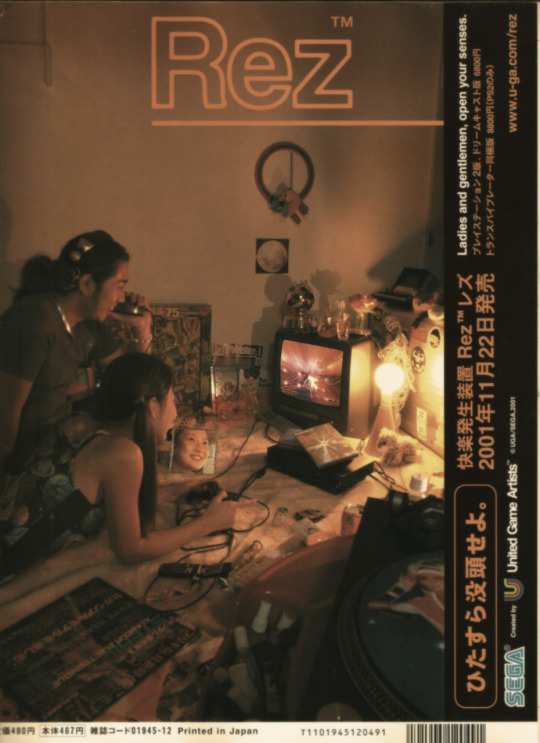
Speaking of the Dreamcast; that recently posted concept video for a third Jet Set Radio that never materialized has gotten me to revisit the original (via kazucrash)…

Here’s a JSR illustration that’s totally new to me (and I’d like that I’ve seen every last bit of officially imagery, though I will admit that I haven’t dug as a deep a hole as I have for Gradius; via sixteen-bit), so perhaps it’s new to you as well?

Another game that deep dives into Japanese urban youth culture is The World Ends With You, and syncopatedid tried doing a side-by-side comparison of the in-game locales with their IRL counterparts not long after the release. There was a two year difference, so not that much had changed…


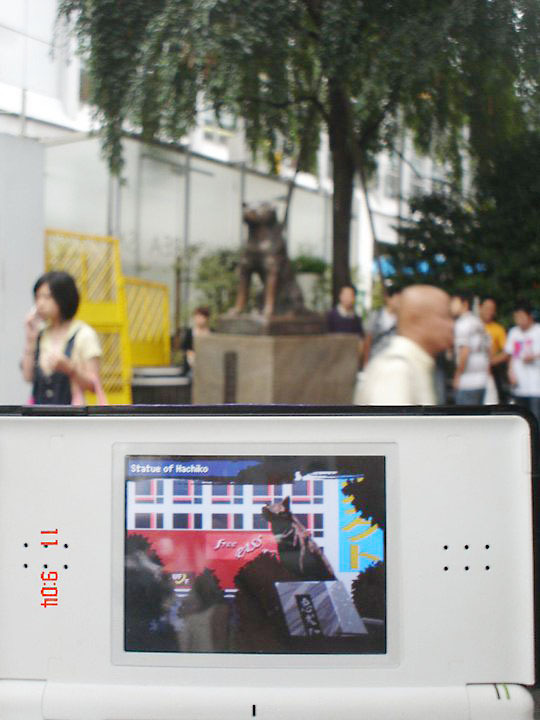

Meanwhile, in Russia, fgsshinyhoard explains: “Samus Aran amiibos can open the ticket barriers of Moscow Vyacheslav train station, without needing a ticket. This is due to an oddly specific RFID in the amiibo that just syncs up correctly enough to the train station’s own reader…”
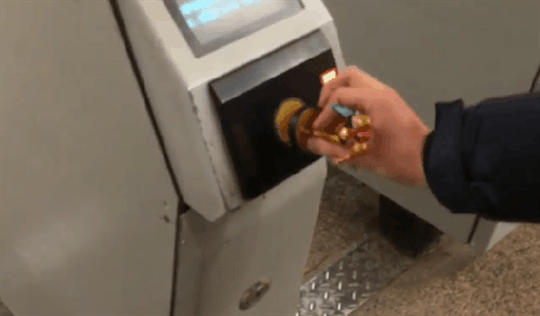
Though back to the streets of Japan… well, more like the rooftops… and back to the Dreamcast; here we have my fave part of Project Justice (via kazucrash once again)…
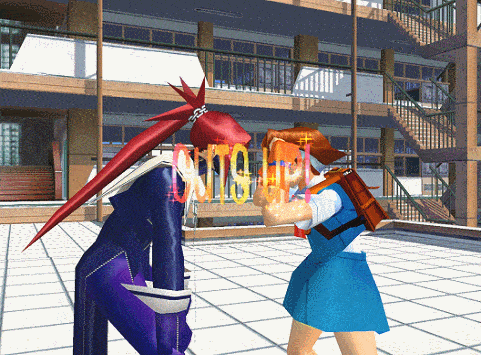
Meanwhile, in another high school, a whole other battle is about to take place (via lunaticobscurity)…

Seriously, there is no better mix than Japanese video games and Japanese high school girls, both circa the 80s (via charliecoffin)…


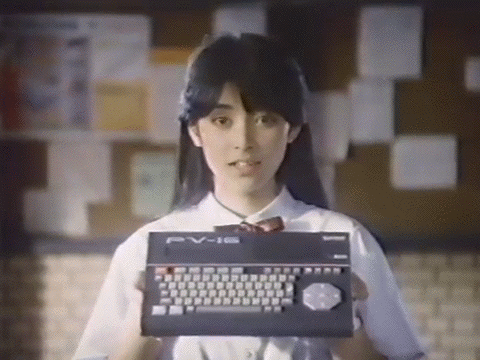
Last time we saw the now iconic Super Famicom box art reemerge as a sweatshirt from King of Games, though you can apparently purchase a few Ronnie Araya’s designs, which applies the same approach toward a variety of other hardware, on shirts as well…





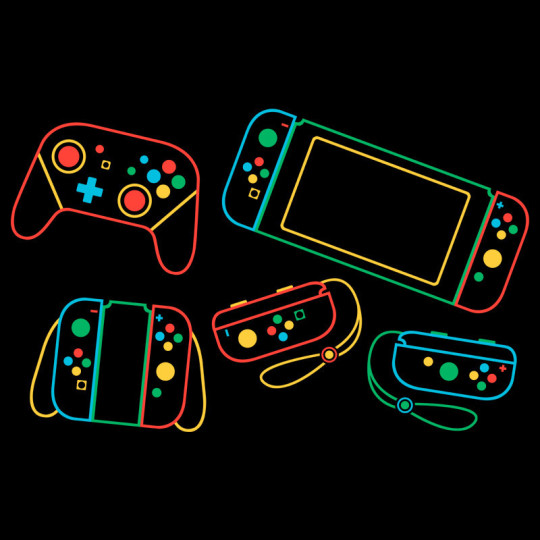
On a related note, here’s what the Super Famicom looks like, x-rayed (via tvgame)…

And here’s an inside look at the instruction for T&C Surf Designs: Wood & Water Rage (via thevideogameartarchive)...

Sticking with sports, I wonder what the rejected shots of these two English football players, getting chummy with a Game Gear, looks like (via sonicthehedgeblog)…

I too would like to say congratulations to Dr. Robotnik (that’s actually a pic of “Britain’s most notorious prisoner”, Charles Bronson, who just got married; via saintdane05)…
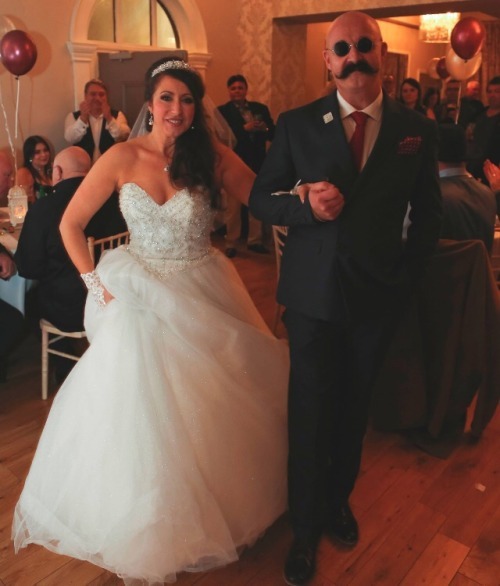
And here’s Dr. Eggman trying to slim down before his wedding day, btw (via muffin-expert)…

Back to the Dreamcast once more; I for one could not have been more disappointed with its version of KOF 99, due to its polygonal backgrounds. Cuz but as kazucrash demonstrates (oddly enough, given his super positive portrayal of the DC), the sprite work was positively insane…

Before King of Fighters, there was Fatal Fury Special, and this bit of nuttiness (via rhade-zapan)…
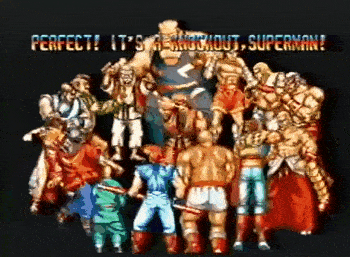
Sticking with fighting games, thewaragainstgiygas presents a #OnePerfectShot of Ready Player One…

Apparently Godzilla has hit boxes, at least according to hitboxesonstockimages…

In response to this picture that was hung sideways in McDoanlads...

... we have the following response from hinaofficial…

The following is a perfect example of why gamingtranscribed is my new fave tumblr…
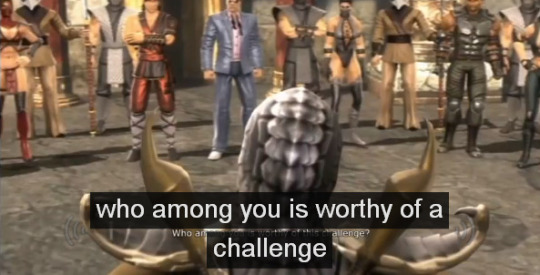
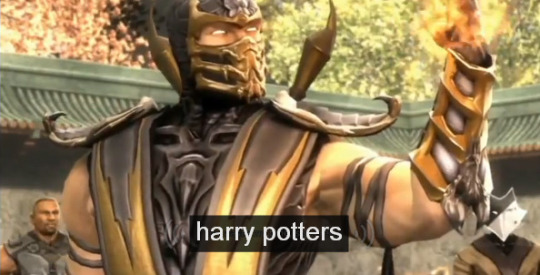
I will never grow tired of this sight gag (via bluephobos)…
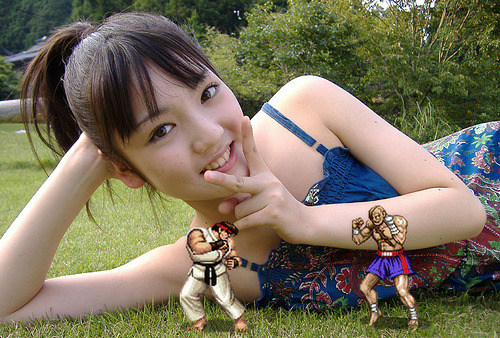
Courtesy of videogamesdensetsu comes a curious example of a fake game preceding a very real thing. Which in this case, is the concept of super deformed Street Fighters going at it…

Meanwhile, oldgamemags recently posted a letter that appeared in the pages of Electronic Gaming Monthly that I can clearly recollect…
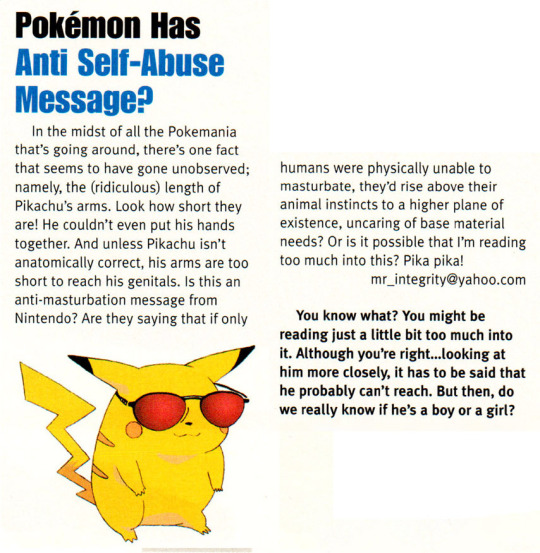
Speaking of Pikachu (via haebane)…
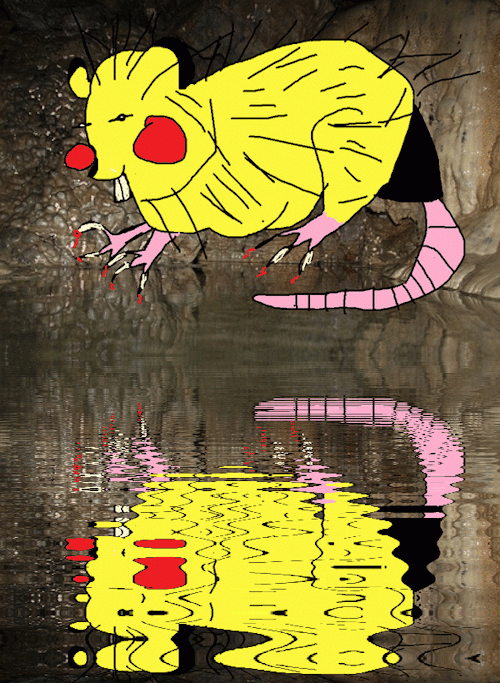
Another fave blog of mine is dedicated to the town of Scarfolk, in North West England, and I could not have been happier to see video games make an appearance earlier this year…
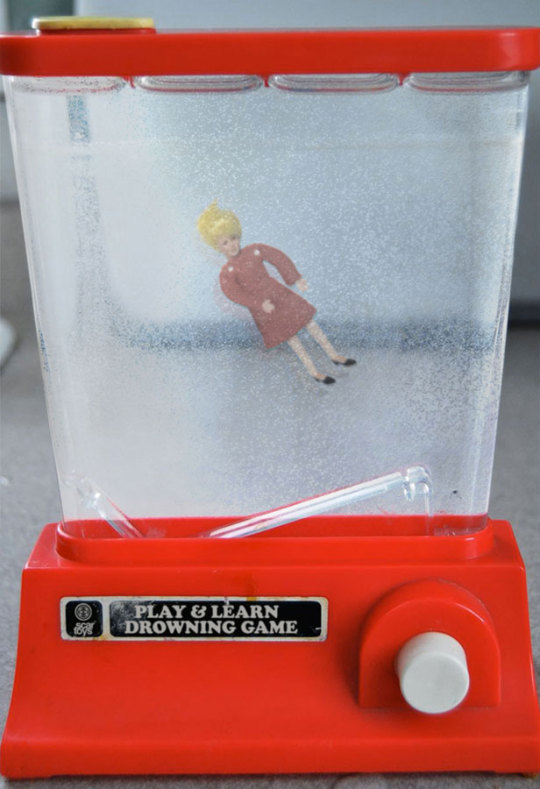

At the end of the day, when all is said and done, no matter how cute the denizens of Animal Crossing might be, they are still filthy animals (via hellomathieu)…

Whereas Kat from Gravity Rush manages to make her dwelling, which is down in the filthy sewer, not only clean & tidy, but also cosy & appealing (as evayoblog also notes)…

If the following gif from prostheticknowledge doesn’t convince you to contribute to their Patreon, then I don’t know what else to say…

You know, it just dawned on me that the Super Fami driven cover of Last Christmas that I posted… well, last Christmas… was published the day before George Michaels’s death…
youtube
Which ride do you prefer? This super deluxe Ridge Racer set-up (via peazy86)…
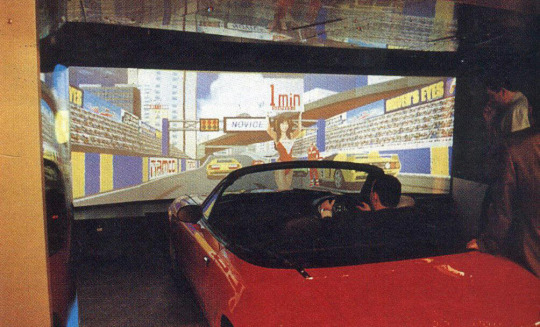
Or this truck with the Legend of Zelda inspired paint job plus mud flaps (via retrogamerblog)…

So yeah, I never really gave Final Fantasy 7 much of fair shake. Was never all that interested to be honest. That was, until I saw these gifs (via ethernalium)…
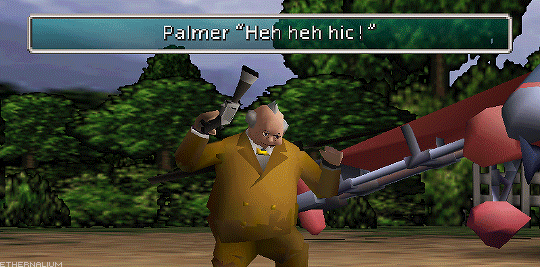

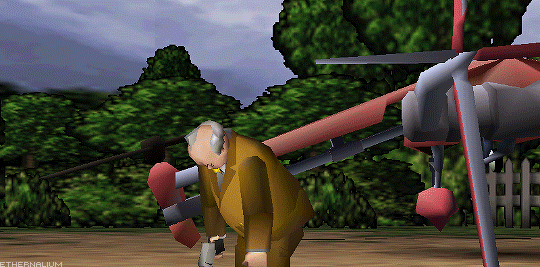
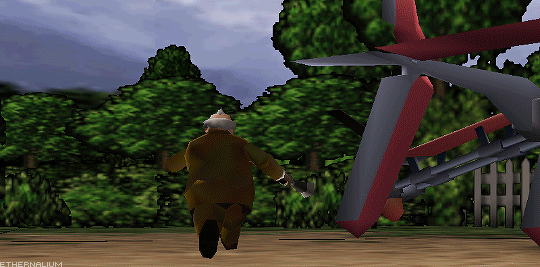
I will never pass the opportunity to post video game related Archie image (via arcadezen)…
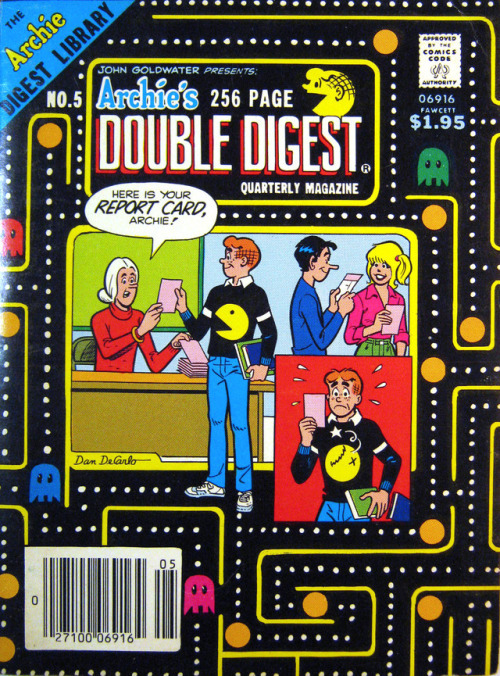
2017 will always be the year that finally gave us a Goemon & Ebisumaru X Beavis & Butt-Head (via midnitesurprise)…

Time for yet another friendly reminder to jump on that Fire Pro train if you haven’t done so already (via shadgandel)…
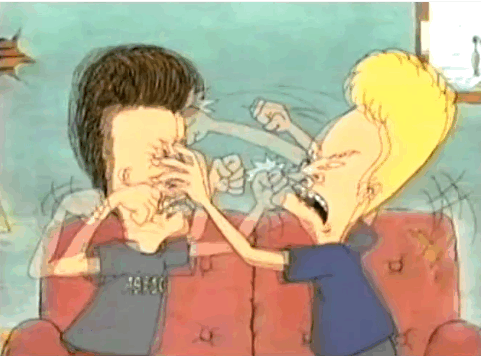

And time for yet another friendly reminder of bat-sh*t bonkers professional wrestling was during the late 90s (via n64thstreet)…

It may not play nearly as well as the games it helped to pave the way for, yet the importance of Pro Wrestling for the Famicom cannot be overstated. At least its commercial has aged like fine wine (via charliecoffin yet again)…

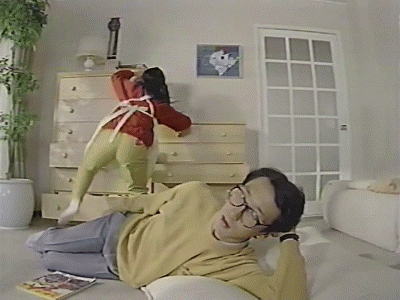

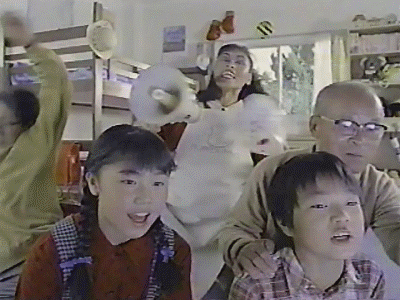
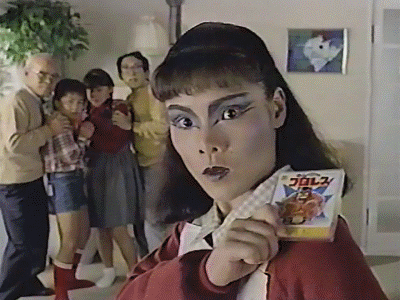
And back to shmups; this holiday season I made a bunch of RetroPies for a client, so he could give them away as Christmas presents (since SNES Classics are still in short supply). And the one game I try out first is MUSHA…

Though I will also play some other game at random, which is how I recently came across Majyūō: King of Demons. It’s definitely recommended (via bizarrobrain)…

titleknown asks: “So, FromSoftware Muppet game when?”

As part of my continued effort to play something Christmas related this time of year, something other than Christmas NiGHTS, I finally have something new! And yes, am late to the Boogie Wings party, but I guess that’s what I get for not following games-are-art closely…
youtube
For those of you reading this who are still in the midst of holiday travel, I have to ask: see anything comparable this (via geekybasket)?

If you happened to get a Wacom tablet this year, and you also have a copy of Okami HD, a FYI (via goldenserker)…
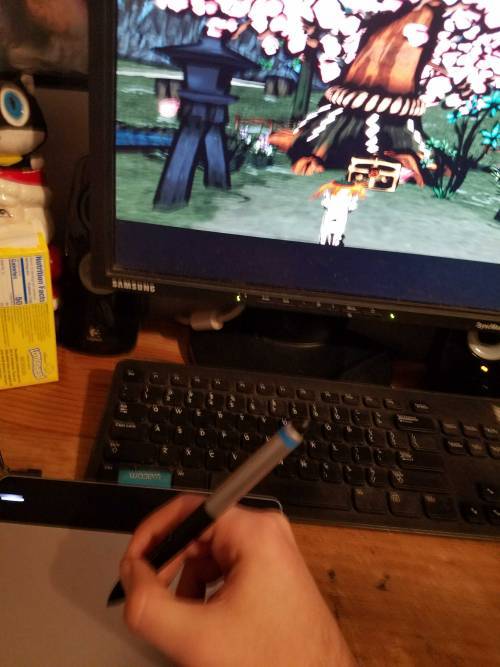
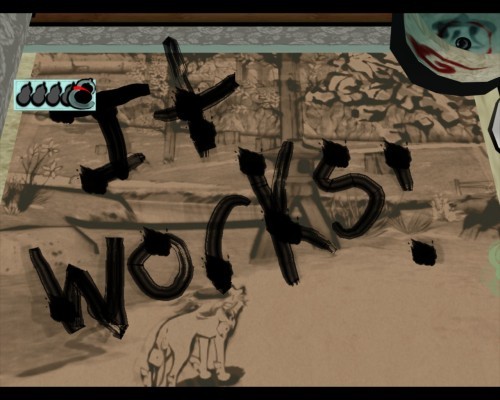
Now, if you didn’t get what you wanted, you can always hunt whatever down on eBay, Though I recommend Japanese sellers only; aside from the fact that their used games are on par with factory fresh here in the US, they’e also super friendly and will often include handwritten notes plus other goodies (via tangobunny)…
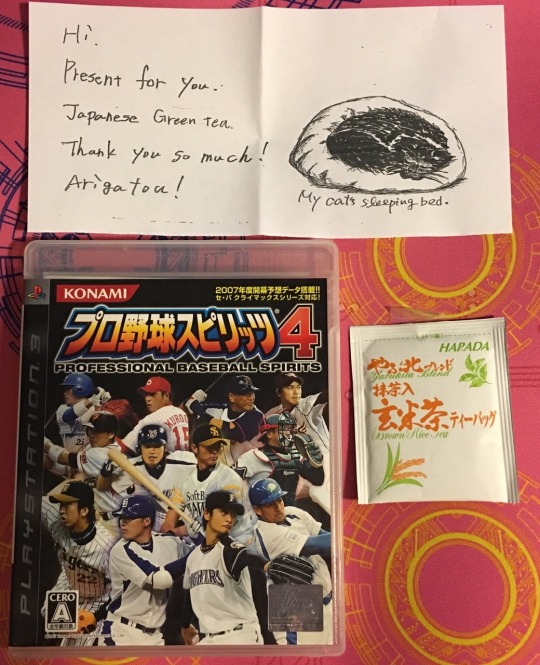
But if you do get something, and I’m talking about a game that’s on a cartridge, I would recommend not blowing on it. Unless you live in a post nuclear wasteland, where there’s sand everywhere, like in the world of Hokuto no Ken/Fist of the North Star (via charliecoffin one last time)…
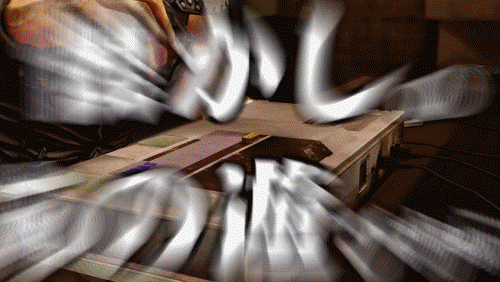
And if you happened to have gotten every game you wanted, great! Just don’t over do it (via relatablepicturesoflisasimpson)…

I began this post with an Earthbound/Mother related vid, and I may as well end with one as well. Take it away SilvaGunner…
youtube
[UPDATE: 12/25/17] Alright, it’s 11:15PM EST, which means less than an hour to go before Xmas ‘17 is finally done & over with. But this other SiIvaGunner Christmas medley is simply too damn good to sit on till Xmas ‘18…
youtube
Don’t forget: Attract Mode is now on Medium! There you can subscribe to keep up to date, as well as enjoy some “best of” content you might have missed the first time around, plus be spared of the technical issues that’s starting to overtake Tumblr.
8 notes
·
View notes
Text
Coming Out
I had been thinking about how to launch this blog for months. I considered the fact that my first post would say everything about the tone of this blog, what I wanted to achieve and who I am as a writer. Deciding this narrowed down my subject matter somewhat, but still left me staring blankly at finished writing unconvinced that this was the way to debut my work. Sitting at the computer to curate something new felt forced, and my brain felt drained of drive. Over the months of preparation, I felt my creative brain waste away and be left with a husk unable to deal with writing from the heart. That was, until, a small mundane event told me exactly what I needed to write. Something personal, something about being Trans. As Pride Month comes to a close, I would like to tell you my most recent coming out story. My name is Jayne Oscar Michael Flowers, I am Non-binary, I am Trans, with these things I am also Queer. At the age of 21, after being out socially for almost 10 years, I decided to come out to my mother as trans, and I would like to tell you this story.
The inciting incident for realising I’d like to put pen to paper- or rather, fingers to keys- was when a poster fell from my wall. My room is littered with artefacts that are symbols of my queerness and icons of my identity I hold dear. My collection of Bee Illustrates posters (you should support her work here: https://www.beeillustrates.com/), a postcard of Marilyn Monroe from Gays The Word, a print of Travis Alabanza (you should support their work here: http://travisalabanza.co.uk/) face each other as totems of what I deem important as my inspirations. Under the poster of Travis Alabanza is a coming-out letter. On these hot summer nights, nothing seems to stick, and when I woke this morning I found the letter scattered to the floor. When I picked it up, I thought fondly of when I got it. It’s an A3 poster of the coming-out letter by the character Mouse in the book More Tales of the City, authored by Armistead Maupin. It’s even signed by Maupin, too, as it’s based off of his own coming out letter. I bought it at an event called “An Evening with Armistead Maupin” at the Southbank Centre. I had gone by myself, a nervous wreck throughout the whole experience, and had bought this poster as a reminder to do something important for my growth later. Tales of the City had always been a role model to me, an example of moves to take for myself. After all, the series Tales of the City came to me in a very interesting time of my life. I had just broken up from an incredibly unhealthy relationship and lost a lot because of it. I was growing up very fast due to how that relationship had kept me infantilized, working a job that I had to bury myself so far into the closet with, in fear of what might happen when I did come out and was realising some of my personal friendships were changing beyond repair. Things were not as I knew them for the last 2 years and Tales of the City gave me some neon signposts to follow when I did not know where to take myself next.
I thought all about this when I held that poster this morning, thought about how I came so far in a short amount of time, and was only seeing it go backwards now. I thought about how this poster held so much importance. I had to make tangible a coming-out experience that really has changed me as a person and the reaction that rehashed a lot of trauma. What follows next is some background, and what I wrote exactly. It also speaks on alcoholism and abuse, so if that is not what you wish to read, turn back now.
You see, when I say I bought this poster for my own growth, I meant it. The coming out letter was written by Mouse, within fiction, to tell his parents he is gay. I found myself in a similar situation to Mouse. He’s an adult, living independently, finding the path for him in a world that shells a lot of shit his way. He’s out, proud, vocal, and yet he hasn’t come out to his parents. I am also an adult, I am also living independently, I am also getting shelled a lot of shit my way, I am also out, proud, vocal and yet I also haven’t told my only parent I am trans. In his situation, Mouse decides to write them a letter. He could have picked up the phone, visited, but he knew this was the right way to convey himself. I knew I wanted to do the same.
I worried when writing this that someone would call the act of writing a letter, and this kind of fictional inspiration, “useless drama”. Why not just call my mother? Why not just text? Visit? Well. I want to start with that I had not spoken to my mother in a while when I made this decision. I changed my last name, to cut ties with abuse and to cut ties with a family name that made me feel dysphoric, and I had decided to do the right thing and tell her what I intended to do, before it was done. When I told her over the phone of my intention, she told me it was fine but then proceeded not to speak to me for weeks. When I did hear from her, try to call her, text her, I’d often get cryptic messages, no response or an answer like the one shown here.

To go back even further, to understand why I couldn’t just pull up my socks and call her anyway, you must also understand that my mother is an alcoholic. A binge drinker. Something that I had had to be exposed to since before I was a teen. I learned very quickly that texting was out of the question because her responses often weren’t as lucid as what is shown here, calling was no good because not only could she just not answer or put the phone down, I did not want to talk to a drunk person on the phone about my gender. For once, I wanted to be in control about the way I came out, have control over this facet of my life. So, I thought about Mouse and decided I would write her a letter. One she could not ignore, that also allowed me to explain myself and write from the heart, if I could find the words.
I remember sitting alone in my flat, agonizing over what to write. I wrote draft after draft and nothing was good. The longer I took to put pen to paper, the longer it had been since we talked, and I had begun not fielding her random texts or calls in fear of her drunkenness. I realised it was not fair to go so long without communication, and I turned to the only inspiration I had: Mouse’s letter. It was a late evening as I sat with a pen, some paper and the poster on the table, reading over what Mouse wrote. I tried not to lift it word for word, but it often said it better than I could have. Do I think it was cheesy? Do I think I could have thought of something better if I agonized over it for a few more days? Yes and yes. But time was not on my side and sometimes cheese is all you’ve got.
“Dear Mum,
I'm sorry it's taken me so long to contact you properly. Every time I try I realize I’m not telling you the truth. I realize that some of my life decisions may have upset you or seemed foolish because you haven’t really met me. That would be ok if I loved you any less than I do, but you are still my parent and I am still your child.
If I'm honest, I'm scared to write this letter. These words on page have been waiting to be actualized. Said to you in some form since I was 12. They were withheld, not because I think you are hateful, because you loved and accepted me when I came out as gay. They were withheld because I hate the unknown. If you know me at all, you will know the fear of the unknown crushes me every day.
I might have never told you the following, if it were not for your radio silence after I said I’d be changing the rest of my name. I almost didn't tell you that, either. I told you many reasons for changing my name. Professionalism. Uniqueness. These are true, but the most important reason is because I am Transgender. More specifically, I am a Non-Binary person. Which is to mean am not a man. Not a woman. I am a person who lives in between those binaries. I use they/them pronouns. So, when people refer to me they may say, “This is Jayne, they study sociology.”
I’m sorry. Not for who I am, being Non-Binary, but for how you must feel right now. I won’t put words in your mouth or project an idea onto you, but I want you to know. This is not a phase. This is who I have always been. And, if you want to love or loath me, at least love or loath your queer, Non-binary child;
Jayne Oscar Michael Flowers.
London has made me feel safer. I have people who are like me, who use the correct pronouns, who treasure me and see me as Non-binary. London never made me queer but it sure did queer me. I can do what I truly want here. But that didn’t ease the ache in my heart when you soured at a new change to me. I know that you may have been happier if I had just come out and said the damn thing. For that, I am sorry.
There’s not much else to say, except that you know me so much better now. I have never done anything consciously to hurt you. I never will.
Please don’t feel you have to answer right away. It’s enough, for now, to no longer lie to someone who has taught me to value the truth. Anna Madrigal once said, “There is only the truth.”
People here send their love.
Your child,
Jayne Oscar Michael Flowers”
I want to finish the story by telling you what happened next. I made the poor decision to tell my mother I’d sent a letter. Why was it poor? Because she spent a week insulting me, bombarding me with texts asking what it was, and if I couldn’t say it on the phone it wasn’t important. It didn’t matter to her how I explained my reasons for choosing a letter, because she didn’t accept it as an answer. Allegedly the letter didn’t arrive, and I had to go through the pain of writing and sending another, it taking even longer to reach her, and her finally receiving it. The two weeks this spanned across were hell for me.
I wish the call about the letter had happened over text, because in my mind it just turns sour so fast. I was already on edge, vulnerable and angry, due to the situation and the weeks leading up to it. My mother told me she accepted ‘what’ I was, and spoke about me as if I was a thing, an item, a creature. At least, that is how I felt. With a somewhat positive outcome, despite her words, I expressed wanting to try and fix our relationship and address her alcoholism now that I was fully out to her. It had driven an irreparable wedge between us, and if I was on a streak of being honest, I wanted to let it continue. As you can imagine, that did not go down well. I will not delve too deeply into conversations after this to save her some privacy. However, it is needless to say they were not positive ones. The true breaking point was when these conversations turned into her insisting I was only angry because of my coming out, because of my own transness. Not, you know, her alcohol abuse or the decade-long emotional abuse and trauma caused by it. My coming out was weaponized against me on several occasions, used almost as a tool of doublethink whenever I brought up any actual issues.
I supposed writing this was as cathartic as it was a cautionary tale. I came out, but at what price? With the other factors that adorned my relationship with my mother, would this have happened anyway? Was the familial estrangement that happened a month later, which I will recall on another occasion, worth my own gender freedom? If you come out of the closet for sexuality, do you crawl out of the cupboard under the stairs for gender? I had clambered out of said closet and ended up in that cupboard, and I know I am always better for opening the door again, even if it only adds to my trauma.
When I finished writing this, I took up the note from Mouse again to read over it once more, comparing it to my own. A thought struck me, and I suppose hindsight is 20/20, which is why I wear reading glasses. Mouse did not continue his coming out journey completely unscathed. His parents had a very similar reaction, so perhaps I should have seen this all coming. There are lots of things you don’t see until you need to see them. Like, as I thumbed over the paper of this poster, I realised after owning this for all this time I had never noticed there was an image of San Francisco impressed onto the page. It made me smile because I feel like I couldn’t see it until now, until writing this. I hope through writing this and sharing it as I begin a wider writing journey, new truths about coming out and living my life authentically will be revealed to me, too. And I hope after reading this the same can be done for you, too. My name is Jayne Oscar Michael Flowers, I am Non-binary, I am Trans, with these things I am also Queer. At the age of 21, I chose no longer to lie about who I am to those I cared about. This was my coming out story.
1 note
·
View note
Photo

Innerview: Ercan Ucer / Grafik Tasarim (Turkey)
October 2008
Image: NA / Grafik Tasarim Dergisi
Note: Take #1 of a design magazine interview.
01) How do you name yourself other than being a versatile designer? Labels aren’t my liking, but they can’t help but be used. Things are what they are. The past year and half I’ve come to the realization that I’m not really a graphic designer. Well, I am, but not in conventional ways or to today’s standards. I find myself every day becoming more and more out of touch with things. I’ve always had the knack for carrying my own cocoon with me, but some days it’s very apparent that I’m enclosed. That aside, anymore I just say that I’m a maker of things, as I like to just make things. I think I confuse a lot of people, actually I know I do. I’ve had people email me confused if my web site is an archive for many artisans’ work. Some think that there is a D, a J and a G teaming up in my basement. One girl asked if I did any actually DJ-ing. Which, I gladly agreed with. I’ve had clients get a little disappointed by what I make for them because it’s not what they wanted, even though they told me from the initial phone call or email, “I like everything that you do. Do whatever you want.” I simply like to make things and hope to dab a bit into many things by the time my time is up. I do know that every day is a new adventure at my soupy head and dining table. I’m calling a portion of my problem, well not really a problem for me but it might be to others and so be it, the “Batman Boyhood Concern”. When I was younger I simply made things. When I was younger I was obsessed with Tim Burton’s take on “Batman”. And I still find it to be my most engaging. I wanted everything in my room to be “Batman” related and if we couldn’t afford the room make-over, I’d just have to take matters into my own hands. My Grandparents lived just a four minute, little-legged sprint down the sidewalk from the school house in the small town I was associated with. Nearing 3:30 PM about three out of five school days, I’d hit the screen door running, grab a sugar cookie and get to work on my life-sized detail drawing of actor Michael Keaton as Batman. My Grandma kept this ode to pop-culture and my life in her bottom dresser drawer next to a giant pile of drawings from a giant pile of grandkids that she had collected over the years. I’d shut myself in her bedroom, drawing my way into a little portion of my master work until “Supper” wrapped it’s way around the kitchen corner, calling down the hallway. Drawing utensils were then exchanged for eating ones and the paper was rolled back up until I’d hit the front door again the next time. Something in me just said to draw it, to do it. Something before even this particular episode or movie was in me saying for me to do and make things. And I just enjoyed it. I found a peace to documenting things and sometimes I’d tag team with my older brother and we’d feed off of our energy to draw and make things. We’d tailor many creative moments after late nights watching movies or attending a wide range of events like fairs, tractor pulls and visiting cities. For the record I believe the “Batman” project went unfinished, but in some extension I’m still making things in this formative format, along with feeding off of other events in my life, past and present. Sadly, when my Grandma had to finally sell her home and contents, I wasn’t there the day the trash was hauled off with that over-sized, unfinished treasure map to my late ’80s world in-tact. In some ways maybe it is better off that it lives as a memory, though I’m sure I’d proudly display it if I had it today. And in some ways I hope that somebody plucked that thing up out of a trash heap somewhere to hang on their wall, to either celebrate another’s dream or as inspiration for their own. I know I’d do the same if I found someone’s life work, even if it was only drawn in a season and only for the sake of making something. I can see that a lot of talent is emerging right now from my generation (mid-20s/30s). In a sense we’re coming out of our bedroom closets to share with others what we can do. We’ve got a firm grasp on our ancestors’ aesthetics and fuse it with a brimming-over upbringing pile of video tapes, video games, computers and pinches of rebellion and rock ‘n’ roll and whatever environment we come from or have access to (at least from my perspective). I suppose the versatile designer isn’t a new thing, as I’m now thinking of some of my favorite and influential master designers of yesterday. But the combination of yesterday’s and today’s technology plays a role in the creative implants of the current versatile designer. I think you’ll find that a lot of people are just up and making a wide-range of things, not because they have to but because they simply can. Everybody seems to be versatile, and many are extremely good at it. Many artist/designer web sites are a file cabinet for all things, all ideas and information (I know that mine is that way, or I’d like to think it is or will be some day). I always say that you can throw a rock and hit somebody who is involved in the arts. And that’s not a bad thing, but it’s this is interesting to me and I think it’s due to the internet and technology. There are a lot of people making things or tying to. It’s good and bad that we’re all kids again? I think I’ll always be a man-child to some degree, but I have to plug into the adult world. Opposed to being versatile, there are a few one-hit-wonders, or stylists that can pull off their own thumb prints with each piece over and over and over, assembly-line like. Personally, I get a bit blahed by this and like I say a few can only pull it off for a career of the “same something to say”. I always think of one of my favorite illustrators, Edward Gorey, when I think about a style that sticks and is truly of the originator. He had his influences and his loves, but he also spun his own world and I don’t think his world caan ever be truly duplicated. 02) What is the relationship between marketing and your designing process at different areas? (poster, packaging, logo…etc) Until recently I’ve never had to market myself in conventional practice. For six solid years I cut my cloth diapers full on independent music-related designs that involved posters, logos, illustrations, etc. Being plugged-in to a small market like Kansas City, MO as a maker of things, and early-on living with a band who knew other bands and so forth, it was easy for me to crank out quite a quantity of work and a wide selection. Still, I’ve always just barely dipped into the arts scene here. My first few years of my design odyssey, there was no shortage of people to form relationships with and most of these people needed things made for their band or whatever. Not to mention I was in my early 20s which amounted for a large amount of energy and excitement. It also got to the point where I didn’t need to be told to make something. I’d just up and do it. Granted, I haven’t made much money at all doing what it is I do (this is something I knew from the get-go) and there have been some frustrating times, but the rewards have been greater and most all of my initial goals and curiosities have been met, several times over. And look at me, I’m making it in Turkey! Anyway, mostly what I’ve fit into is “Trickle Down”, or “Word-of-Mouth”. On top of creating my first five or more years, which was squandered into the late night / wee morning or on weekends, I was working 40 hours a week (oh, still am) at day jobs. I was a janitor and grounds keeper for many years and currently I do data entry in an office and have a better schedule and sleeping pattern. For a season or two I was even working 60 hours a week to make ends meet, plus a full-time girlfriend (now my wife) and working all night to meet design deadlines (thankfully independent music industry deadlines can be very relaxed and since I don’t get much money, I can pretty much make my own deadlines). I was at times scrambling between 10-to-15 projects at once, and only to basically be paid in cheeseburgers. Certainly, the ultimate goal and position for me is to someday make a clean getaway from the day jobs. I will still dabble in music-related practices, but I’m finding new avenues and realizing the powerful and simple marketing tool that the internet has to offer. Although I butt heads with computers and technology, I’ve learned to just be myself when representing myself. But, my biggest “butt” will be with myself. I can never do enough and I’m so very hungry. 03) Can you tell us about your working environment and your different feelings or extraordinary events that inspires you? Ever since I was a child, my working environment has been in my bedroom hunched over at my bed or whatever work station of the week I’ve built. I could always be found drawing or building something, or putting culture into my system. Though, my working environment extended beyond the bedroom as I grew up a child of rural farm and country life in the middle of America. I made dives into the sandbox, the fields, creeks and woods. I certainly believe in a home base of operations, mostly a place to find peace through the pieces, store my treasures and to unload my skull cap. And I’ve claimed to friends before how I could easily stay alone for weeks or months on end. I don’t get bored and lonely. Like my childhood on the farm, I still see everywhere on the outside as my working environment as well because I do my most thorough thinking / observing while out of my clubhouse comfort zone. Don’t most all who dive into any area of the arts and crafts? Given my odd schedule, I also must spin wheels rather quickly. So, I suppose the clubhouse external is the feeding and processing ground until I get the moment’s time to get it out of my system while at my desk down in my basement clubhouse. And I need this. It’s my cure, though it can be my downfall. I’m a major fan of extraordinary events and tend to find humorous and peculiar ones to be more my taste, and more-so in retrospect of the event. I’m a fairly anxious guy, so inspiration usually comes after my own post-dramatic stress of a situation. I feel to be blessed with a certain quality that attracts odd circumstances, or maybe it’s just in over-kill-over-my-head. Extraordinary has its own brand of fast pitch. More often I find inspiration in places, events and things that are fairly run-of-the-mill and every day ordinary for any person, which can give them an added cushion of “extra” for me. Some of my very favorite designs are remnants of everyday people, places and things. I do a lot of looking down or glancing off into space, collecting while I’m out and about either mental delights or physical ones that have been discarded. Since I was young I’ve had a habit (good or bad?) of bringing things home. While most men bring booze, golf clubs, sports cars, tools, even ladies home…I started dragging pieces of the farm to my world under the bed. I believe this started with bugs and the only type of spider I find comfort in, known to me as the Granddaddy Long Leg. When I found out that these long-legged, tiny had wonders would pass away of suffocation and frost bite after rounding them up in a glass jar kept in the freezer, I started dragging pre-dead things home to spare me some emotion. Not too unlike the family farm dog, I’d drag animal carcasses, parts and pieces to my bedroom. I was a gatherer before I was a hunter. Though, part of this was instilled in my boots while on excursions with my father to hunt animals like quail, rabbit, squirrel, turkey and deer. My Dad would let me keep things like turkey beards, feathers and feet. He himself had an impressive collection of deer antlers. When I was 6 or 7 my grandmother made me a denim backpack lined with plastic to collect the day’s dead things in. My Dad would shoot something and toss it into my backpack. Once home we’d dump it out to field dress our dinner and wipe out the lining for the next hunting trip. Mom and Dad have a couple picture books filled with the conquests of kills. They also serve nicely as a chart for watching four children grow-up as they jot the front lawn or pick-up truck bed landscape in front of my Dad’s kills, with big eyes, grins and sometimes a tongue hanging out in mimic of a dead deer’s. Further-on the photographs reveal the children as stars to their own still scenes with their own bagged game. A future goal of mine is to have an exhibition of blown-up family photography of this genre. To some this may be quite strange or extraordinary, but it’s not unusual for me at all and nothing out of the ordinary in response to the environment I grew up in. It’s only one tier of the cake. I’ve had many events in my life stick-out (check the “history” on my web site), but a singular extraordinary event that sticks out in a way in which it triggered me happened when I was six years old. I was at the school playground during Kindergarten recess. All alone I sat on top of a tall slide and watched the rest of the class playing games together, rummaging through the playground’s wood chip obstacles and tennis court tag playing. They were all going and doing and jumping and seemed to be enjoying themselves, but it just didn’t feel right to me. The playground sat directly next to a well-traveled road and it too was buzzing behind me with cars, trucks and tractors housing people on the go. Even though I made my own decision to do my own thing, sitting atop that slide, I felt extremely alone, confused and secured inside a most intense sadness of insecurity and strangeness to this scene, to the extended world I was coming up into. I can still feel a connection to this moment and I’ve had two or three other episodes like it, but not nearly as bad. Jokingly, I’ve maybe spent three of my nine lives during these moments. But, the one thing I can’t precisely channel, looking back up that slide, is what exactly happened after my observational anti-social breakdown. I do know that I blacked-out, fell from the top of the slide and hit my head really hard on the ground. The next thing I remember was sitting in the back of my parent’s car, smiling at the blue sky and excited to leave school early. Something important announced itself that sunny day. I wouldn’t exchange my early observations, inputs, memories and moments for anything, even the things I did this morning I wouldn’t trade. It has all compounded and fueled me in a way to how I got to the right now. When that can be channeled and floated on, then the moves you make can be pre-calculated and form purity to them. Notes like that aren’t always hit perfectly, and sometimes you’ve got to miss and even collapse to the floor. But, when the notes are on, you can really feel it. 04) When did you discover the impulse that led you being a designer? This impulse to create, to leave behind a paper trail of some sort on my impression, has always been kicking around in me. I don’t remember a time when I wasn’t doing or making something. Even now, creeping on 30 I’m finding that I’m more in touch with my former self than my current, chipping away at something. Actually, the former and current are the same person. I’m not really living in my past, but I’m moving forward with it fully there and in use. Which, is another calculation of how all things gathered and hunted in one’s life can lead to the now, I suppose? Though, I don’t mean to randomly aim arrows. From a young age I was dealing with design (as all of us “designers” did and do), but at the time didn’t really make a proper connection to it. I knew how to spot Beatles records by their green apples. I was a fan of the “Star Wars” logo type and knew it was its own calling card and mega cool. I was very respectful of my nation’s flag and very curious of how one got his picture on money…and many other things that we all find developmental comfort or relation in. And while growing up on a farm I became quickly associated with tractor machinery identities and seed corn logos. With my older brother I’d collaborate on mini magazines and we also would cut and clip exciting words and phrases out of Mom’s magazines and paste them down. I always chose to “Visualize” my book reports in school rather than “Verbalize” them. I must confess there was many times where I wouldn’t even read the book and still score a top honor with my interpretive illustrations based on my own guts and thoughts. Which, sometimes a designer doesn’t have time to read a whole book before slapping a cover to it. When the age of 9 or 10 came around I was the winner of a wide-spread logo competition for a roller skating / bowling alley business in a nearby town. I had a hunch I’d win as every other submission, even those by students 8 years older than me, didn’t feel inspired or realized or even logo-like (whatever that means nearly 20 years later). I still like my logo. Though, when my family drove by the facility after the sign was finally up, I got a real-world shock of disappointment as the owners had took the liberty to butcher my design and it just wasn’t the same. It was ruined to me. It was my first design disaster and it hurt at the age of 9 or 10, just like they hurt now. I was also a big fan of collecting and mimicking logos and mascots for collegiate and professional sports teams. There was a time when I claimed, “I want to be one of those people that makes those sports logos.” Not really knowing what people who made such things are called, but I knew that I wanted to be involved somehow and I knew how to make sense of them (I also celebrated a go at trying to design athletic shoes). My love for those sports logos moved into sports stadium design and architecture while I was in my early teens. I still have pages and pages of baseball stadium designs I’ve invented. However, a poor track record in mathematics finally convinced me at 18 that I probably couldn’t make the cut in such a technical field as architecture without being held accountable for faulty engineering. It was a hard reality, though I eventually would work as a night janitor for a successful stadium design office when I first moved to Kansas City, MO. So, technically I did work in sports architecture. The summer previous to my non-math skills realization, I was involved with a wide-selection of fellow high school artists to form the first annual Missouri Fine Arts Academy. This opened me up to other channels for future development with the arts. And I became more open and dare-I-say, evident of my ability for “artsy”? I also was becoming influenced by new things like typography of graffiti (even though I only practiced graffiti in sketch books and had no idea what typography was until two years later). The last year of high school I decided to go to college for something called graphic design. I enjoyed art and making things, but from what I understood graphic designers guaranteed “more chunky of a pay check”, something I’m still looking for. It wasn’t until receiving a great helping of design education at Southwest Missouri State University (SMSU, which is now Missouri State University), that it really began to seep in what a graphic designer was defined as. The illustration and design department at SMSU was a unique opportunity to study with as my instructors were from Eastern Europe and Russia. This brought a great perspective on not only the largely hands-on work that I was interested in pursuing but also from a cultural platform. Most importantly, I learned how to build and burn from the fuel that I once had while making things in my bedroom as a child. This took over two years of redevelopment, oiling and eye opening to get at what I had in me from the foundation get-go. My instructors helped me to see this, along with a lot of hard work. Though, looking back I don’t think I really worked hard enough. At times, it wasn’t an easy transition and at times I was laughed at by peers. One such instance early-on in my studies was when I said, “I’m going to take the graphic design route that doesn’t involved computers.” It wasn’t arrogance speaking, rather backwoods boy. A couple of friends thought I was crazy for that one. Later on those same friends would look at me very strange when I thought that typography class involved map making. After many paints of red face, and once knee-deep into my studies, I had second thoughts about graphic design as I fought with the screen barrier of the computer monitor, the route I didn’t want to take. Computers choked the fun out of creating for me. Frustration was sensed from within and out as I was at a loss with my once creative love and my first computer design instructor was pretty frustrated with me. Along with this struggle, I visited many professional design studios and always came back very unsatisfied with the “profession” I was getting into. It lacked what I was searching for, the thing that kept me up as a child making stuff. A professional design office atmosphere might work for most, and that is perfectly fine, but I for one wasn’t about to give myself to another man’s dream, spending 40 years pushing around on an assembly line screen. I’m painting a terrible picture for professional design offices and I apologize. I just didn’t see myself and the way in which I thought and worked in that environment. I knew what I wanted to do, but had no idea what to do with it. And I for sure knew it wasn’t going to be wasted on computer monitors (Note: I own a computer and use it. It is a remarkable tool and has been a good/bad addition to the industry. But, a computer is not design nor does it have a magic button that pukes out designs like people back home have once thought). Sheepishly, I took a chance on myself the last couple years of school and gained much needed confidence in doubling up design with illustration classes and learning to merge the two. It was a lot of work (even though I don’t think I worked hard enough), but something clicked and I felt like something could come of it. Outside of class I was catching fever as well, starting what would become my own business and shuffling a large amount of clients. This was when I started getting into independent music graphics, merging my love of music with my love for making things, and meeting people who needed me to make them things. The last couple of years of school were very important. I learned to reconnect with myself, to poor into my work to where it became more than just “work”. I would then finish up the rest of my design and illustration courses and secretly drop-out of school to pursue a higher calling to do my own thing. 05) Is looking at life always from a different angel, the designer’s necessarily ego? Most any area of most any job / skill / talent / business doesn’t come without some ego hurdling. The ego is amped further within the arts. Inflated achievement comes with ease when your voice gets a little loud in a “scene” or beyond, when you start to make some ground or just think you’ve got it going on. It’s easy to become your own Hallmark moment. I’d like to think I’m fairly grounded, but it’s hard not to feel the eggs weight the other side when I know I could be sitting on a couple of golden ones. And everybody asks me why I’m not doing this full-time, why I don’t have my own book, why this and that. Working a day job can help matters upstairs and can also add a unique fuel to the equation, but it can also be a nightmare pushing everything to the back burner because of a day job. It can hard to keep up with everything. But, life is life and I’m best when I don’t try to push it so hard that I end up breaking instead of making. I have to just tell myself that I am a man and a man who happens to make things. Even if those things are on the side, and at times have to stay on the inside. It doesn’t mean that I’m better than somebody nor am a “somebody” because I’ve found a certain something within me or a way to leave my mark. I enjoy my life, have fun and feel very fortunate, even if I do find it all quite silly or serious from time to time. I think one needs healthy doses of reality and a whole heap of humor to make it. Besides, I have no answers. If you know somebody with it all figured out, have them call me. Phones tend to bring the egos out, but I’ll at least give an ear. What helps me is to find comfort and ease in venturing back into my child manner. I find peace in just Be-ing, but not in some freak-out way. I’m much more content and find peace when I’m either looking at the world through a certain lense that I might qualify for or just making and enjoying the act of celebration in creativity. The moment I start to think too much about it all or start to answer questions for interviews is when it can get a little dangerous. I feel odd for the people who sit through an entire interview with me because half the time I have no idea what the heck is going on. Creative voice can be a dangerous stomping ground. We see individuals all the time start to play God with their arts and crafts to where they become the work of art. They say it’s “who you know”, not “what you know” and this may be true in some fashion, but I think people play with their gifts a little too hard to become something other than a someone, to where they don’t even recognize themselves. It’s a place where the art takes possession over them and the things and even the people that they pioneer. It’s sad. And another thing, it’s sad to me when creative people resort to outside influences to fuel themselves. This is another topical can of worms, but I get extremely sad, frustrated and the feeling of cheat when I find a great piece of art was created under the guise of chemical enhancement and or power pills. I don’t think I’ve ever had a creative supply shortage. Even if I had the full-time employment of my own craft, I’d still have a back list added to daily as there isn’t enough time and resources to accomplish everything I want to and I don’t have a lack of work ethic or passion (though sometimes I might think I’m lazy). It’s evident that those who are steeped with some intuition to create and spew out what they’ve got in them have been blessed and cursed in some way. I feel very blessed to have this ability of self-contained entertainment and amusement and the strange need to put my stamp down here. Though, it can be a wreck when I stay too deep within myself. It’s hard to find balance sometimes, but if I just take things one step at a time, I’m fine. I think gaining wisdom through maturity helps and I know that my energy and will-power have died some and of late because I’m getting older. But, I’m leaning on this as a beneficial tragedy and it excites to want to always be making my best work. I think I say and do some dumb stuff now, but I’m positive it’s less than yesterday. 06) Can you inform us about graphic design’ s one of the important field, package design and your sketches? / Tell me about the sketching and process of packaging. There is a certain amount of image longevity that becomes attached to packaging. I’m not experienced in much more than musical CD packaging, but I think a long life span especially applies to this in the iconic halls of pop-culture. Certainly, my little kicks aren’t associated with the big boy playground pop-culture world at all, as I’ve only floated around the local independent music scene and a few magazines and books. Though, who knows as time passes and perhaps within the very small circle I’ve operated in, it will tell. Besides, it’s not the reason to make something and/or package something (to win awards and hearts or to make something cool-lookin’) but if you can add some meaty eye candy, then so be it and why not? I love poster design because there are endless possibilities to exhaust, many ways to work reach-and-grab, to be of-the-moment and intuitive. If something doesn’t work all-around, it’s throw-away and will die soon like house flies. CDs are so different, at least for me, and they can be quite intimidating and sometimes a nightmare. I do a little bit of sketching, but more-so the process and evolution of diving right into the CD package is the sketching for me. If I’m rewarded with an ample amount of time to work on a CD I usually make it happen in three different sessions, or what I call “incubation stages”. This allows me time to sit on ideas and to come back to them with fresh perspective and clear head, to play or spin off ideas and such. With the way in which I work, I tend to feed off of my day-to-day (sometimes minute-to-minute) emotional handy work. It can be a little strange though as I say I don’t like to think, but I’m no stranger to it and thus I can easily obsess over wondering the what-might-have-been with something like a CD package or anything after it’s over. There have been moments where having an extended deadline for a package can cause too much to happen, too many sessions. And I’ve had some CD packages that the musicans/band have taken anywhere from six months to two years upon getting to the final. You know, people taking their time, finishing up recording, life stuff and production blahs. These typically turn to nightmare with the band or a third party (another designer or the printer) ending up with passed around digital files, putting the project on the mutated chopping block. CDs can wear me out. Especially in the age of digital and “everybody’s a designer”. That’s another ball park though. Though I appreciate not cramping my time and style, as I’m a busy boy, I do believe my best packages have come down on me at the last minute, and usually on the lowest of budgets. And I mean cheap, major cheap. Sometimes I only need one session to cram for the final. There have been times where a client tells say, “Hey, I’ve got such ‘n’ such idea to release a CD.”, and instantly I’ll have the image in my head and make it and it’s perfect. I guess it just depends? 07) What are the benefits of making global designs for the designer? I love a body of work, one that breathes and not only serves as a timeline for the maker, but also for views and observations on life itself. I like the idea of the paper trail through the woods. Even if it goes barely used or undiscovered in its own time, it still becomes a piece of time. Who knows, maybe it will be a major highway further down? Of course anyone who makes things in a passionate format and routine can’t help but be a tad bit selfish when it comes to dishing something up. Even if it is for some other body, it is always from an original body, the creator. Anything that goes global is still connected to that first breath of singular life. It means a great deal to me when something silly that I get tickled out of bringing to life, in some aspect, makes it out of the nest and causes others to react in their own way, mostly positively and even sometimes negatively. In today’s fast-paced world of millions and billions of images and things flashing, it really does mean a lot that my meager things have made it in some strange and oddball small-scale way. Even, if it’s just a grin or a double-scoop by someone of a little poster on a wall or in a magazine or out there on the internet billboard. After starting to make things on my so-called professional design odyssey for only a few months, I had people track me down to say how their bedroom walls had few places to hang anymore of my work. This just floored me as I am not one to have much bare space on my own walls of other people’s work. 08) Can you explain the relationship between marketing and designing? Like I previously mentioned, years of marketing for me came by word-of-mouth or by people seeing my work in the community or in magazine competitions and book publishing. Something I tell artists and designers is to get the work out there. Even if it’s something you’re doing in the off hours, just get it out. I know that I have some things that only I and my basement will see, but a lot of what I make gets out there. And if the people find something to listen to within your work, they will come. Even if it’s just one or two, then that is worth it. I feel I’m finally at a place where I can sit back and re-learn some things and actually look at the things I’ve made, the pile I’ve built. I’m learning to use the internet as the tool it is to pass emails to prospective clients or industry folk and to find ways in which to get my new web site some traffic. I have to take it a bit slow though because I only have so little time to actually make things that it’s hard to find the time to push that stuff into other areas. There aren’t enough hours in the day. Also, I definitely believe in getting the work to design competitions whether local organizations, national or world-wide. I recommend dumping as much stuff as you can every year, money-willing of course. People on the other end start to take notice and begin to look for you, which can turn to magazine editors leaving positive messages and emails, interested in your work. This can also lead to interviews and other special things. The work in magazines has been the most important for me as publishing can extend many world regions, gathering a lot of feedback. This can lead to book submissions and beyond. I’m not sure if I’m answering this question correctly. Marketing in other ways…? A design is a marketing tool. Though, a designer does play eye-grabber, a designer is not really a marketer, but I guess it helps a bit to know how to sell something? I had friends in college who studied marketing as well as design. But, it’s an area I’m not familiar with other than getting people to get excited for a musical group/sound/feeling/expression by way of poster, CD or logo design. It is marketing tool though, especially when working with a client. It certainly is not only what the designer can bring to the “product”, but you’re also working for somebody and trying to sell an image or an item and in the case of show posters, selling a venue or the place the poster is hanging or even the scene and city. I think this can be a tricky walk. I’ve been fortunate to have some success with great clients and great projects to where things work out lovely. I guess it helps that independent music graphics kinda start out in left field? Though, I don’t think that the work should limit itself. I think it’s great when the work speaks to anybody. There are times though where things don’t mix well, whether under the weather or client-wise or consumer. It’s just part of the deal. 09) Does any of your designs have an unforgettable story? This question has been asked a handful of times and it’s always answered the same way as this story is one that I won’t forget. I think that everything I make has a story to it. Whether it’s an unforgettable one in terms of production on my end, or one that is contained within the background of the piece internally, everything has a story. The “Whatever Makes You Happy” CD package design I made in June of 2002 for the band Elevator Division, is one of my most memorable moments, story-wise and design-wise. The following has been told so often for interviews, that I’ve now come to simply plug in a script that I’ve already spent time with to answer such a question. I don’t aim to cheapen this interview by including something that I gave for another, but here goes the story. It’s pretty whacky and ended up being one of the best things that I think I’ll ever make. It was a special run of 250 homemade CD packages for the band Elevator Division. I’ve had many projects that demand more production time than my little brain imagines, but this one was the worst. Actually, the finished piece is a lot tamer than my initial idea. Though, the final image’s concept, married to what the band was communicating on the disc inside, is way better. The idea came at the night I started printing. Well, actually it was spray paint. I had an image made for a month or more and then changed it at the last stroke of inspiration. It married the themes for the album “Whatever Makes You Happy” perfectly. With reflections of war and relationships in the songs, I made an image of a hand shooting off its index finger like a missile. It was the idea of shooting off one’s options and making decisions. It was aggressive, inviting, serious and humorous all in one. It was not only fitting for the band / music but also to the national / world agenda and climate. I went to war that night with many cans of spray paint and the idiot mind to do two-hundred and fifty, all in one massive sweep, and in my basement, which is something I will never do again because I could have died. I will probably also never be involved with another package like this again (take that back, I have been). Anyway, each one was hand-cut from cardboard and handmade stencil sprayed and rubber stamped. Inserts were cut, folded and glued. At the last mist of red spray a crack of thunder shook the massive turn-of-the-century home and I bolted from the basement and out the front door to a down poor fit for Noah himself. I was like a much less cool version of Dr. Frankenstein though. I leapt off the front porch and slid head first down the embankment and into the street turned river current. Like a taxidermy nightmare, I was born again. The drug dealing squatters of the home across the street were on their front step perch per usual summer evening, looking at the fire in my eyes and the red paint streaming from ears, nose and mouth. It was a high much higher than that of chemical substance. Well, maybe a three pack of design, life and paint fumes. -djg
0 notes
Text
Article contributed to Five Star Arts Journal by Jay Michaels
Comic Books – like their characters – have a secret identity. The mild-mannered paper and ink funnies are also the next level of Greek tragedy or Shakespearean epic.
Comic Artists – like their characters – also have a secret identity thrust upon them. Hard-working children of immigrants throughout the sixties grabbing a job in a time when such things were scarce drew fun and fantastical stories about improbable human beings … and outer planet dwellers. These progression-of-image books have – thanks to Godlike advances in cinema and the paranoia of psychiatrists throughout the fifties and sixties have become the new da Vincis and Picassos.
Sadly, like their characters, these artists were always lauded for their work. their stories are the fodder of -well- comic books.
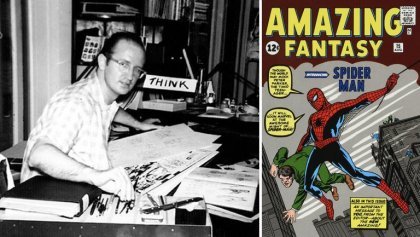
Ditko tells the story of Steve Ditko, a comic book illustrator virtually forgotten by the masses, but celebrated by comic book fans everywhere. Chronicling his rise in the comic book industry, Ditko was instrumental in Marvel’s success by co-creating two of comics most iconic characters, Spider-Man and Doctor Strange and several of DC’s silver age icons, Hawk and Dove, Shade the Changing Man, and the Creeper. Ditko also worked for virtually every other publisher of note including Warren, Charlton, Pacific, and Eclipse, co-creating other iconic characters like Mr. A, the Question and Blue Beetle. he also created some of the 1950s most startling imagery in sci-fi and fantasy comics. ironically, Spiderman was meant to be one of those fantasy one-shot characters for a comic book called Amazing Fantasy. Stan Lee, planning to cancel the poor-selling monster book, let Ditko draw one of those far-out characters for the last issue. The rest, as they say …
The Daydream Theatre and TheatreLab NYC present DITKO, a play written & directed by Lenny Schwartz on October 1 & 2 at 7:30pm Tickets: $15 in advance at Ovationtix.com and $20 at the door the location of TheatreLab is 357 WEST 36th STREET 3RD FLOOR – NEW YORK
Some actors have the honor of playing Hamlet, Romeo & Juliet, and Lear … others have a more lofty experience. Derek Laurendeau plays Steve Ditko; Dave Almeida dons a cigar for his role as Jack Kirby; Anne Bowman plays a mystic master – no, not Doctor Strange … Ayn Rand. And Geoff White takes the elevator to the floor ABOVE Mount Olympus as Stan Lee. The avengers assembled also include Samantha Acampora, Christopher Ferreira as Jerry Robinson/Dick Giordano (talk about Marvel AND DC), Mindy Britto, Emily Lamarre, and Timothy DeLisle.
At the New York Comic Con in 2010, Stan Lee entered the stage and someone from the back of the house screamed “YOU’RE A GOD, STAN” We asked the cast … well is he? Well, are you? And what’s it like playing Gods.
Derek Laurendeau:
To me comic books aren’t becoming a religion, they are one. As with most religions you have practices, prayers, meditations, and most of all stories that give the moral standards and practices of them. Comic books in their own way share many of these. Many people routinely make pilgrimages to the conventions or their comic book shops to share in the collective story telling of hundreds of artists and writers. The whole community (artists, editors, writers, fans, etc.) shapes these stories. The stories give us the hope and ability to cope with the world around us. The comics are also a mythology on their own. Superheroes are god like and while the stories can be bombastic, heroic adventures at the end of it all the heroes themselves are just as human as we are and through that relatability you can gain strength to overcome any difficulties. Also like most religions there are divisions that you see when stories adapt and change. Most recently the Miles Morales Spiderman comes to mind as an example of the rift that can divide comic fans.
“I feel like we’re not playing gods. Ditko, Lee, Kirby, and Robinson were humans just like us.”
They had their flaws and faults just like anyone would have. The fans may see them as these deities, but at the end of the day they were just men and women creating from their imaginations. They created these characters not knowing what would happen. The act of creation is what they knew best and by putting the work in and giving their art every bit of energy they had they made magic happen on the pages. I feel like my responsibility to the role is to show the humanness of these great people. Yes they created heroes that will not be forgotten any time soon. But Steve Ditko, Jack Kirby, Stan Lee, and Jerry Robinson all started at the same place behind a table with nothing but an idea, paper, and something to write and draw with. The truth is anyone can do what they did as long as you have passion and are committed one hundred percent to making your destiny happen. However I do feel an extra responsibility to Ditko since very little is known of him and for a lot of people seeing the show it was the first time they had ever heard of him. So i feel a duty to do my best to represent Steve as the sure minded, smart, and talented artist he was.
Geoff White, like the characters he plays (Stan Lee) was a bit more irreverent.
Growing up in the 60’s, I was the usual comic book kid… I occasionally grabbed a Superman or Spiderman. I’ve always had a healthy respect for the art form, but as I began college and studying theatre, my focus changed and comics faded in my life Except for my many friends who are avid collectors. But, as an Actor, I do feel the responsibility of being true to any character I portray, but obviously playing Stan in the city, next to the Comicon is a little daunting. Fortunately, Lenny is a true Fan and an insightful Director and I truly feel the audiences will enjoy the ride as much as we do.
Dave Almeida plays another king. Jack “King” Kirby. The man attributed to some of the greatest comic book characters of all time – who never got the respect he deserved … until after his passing.
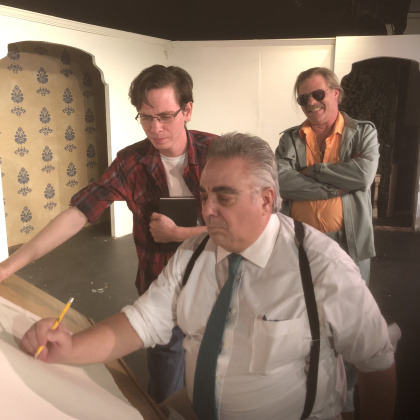
We the public may consider these creative writers and artists “gods”, but I would guess that they just considered themselves just “working Joes”, and getting paid for their services, just like screenwriters, journalists and commercial artists did at the time. These wonderful people gave us role models without even realizing it; role models who change the minds and hearts of a post war generation and their children.

Christopher Ferreira playing two comic book legends shared his thoughts as well.
When I was in grade school at that time, comics were the safe place where social outcast bookworms could find comfort in fantastic stories about heroes and a fantasy world. It was ours. Now comics are everyone’s. Now I’m the expert who pretty girls turn to to learn about this world of mythical legend. Now I feel like the prophets of old, leading new followers to the wonderful teachings of pulp fiction legends. I absolutely feel a strong responsibility to accurately portray such legends as Jerry Robinson and Dick Giordano. I met Jerry twice in the later years of his life at the San Diego Comic Con and I was so blown away by his intelligence, exuberant personality and humbleness. He did so much important work to get creators the credit and recognition they deserved. I can only imagine how he encouraged and helped Steve Ditko in his early days of coming into the comic book industry. Jerry was such a force in the comic book industry. So my goal in bringing him to life again onstage in this version is to show how human of a man he was. Comic book creators are people who care about the human race, I feel. They write stories that show the best humanity can be. Creating heroes that they wish we all could be.

Anne Bowman practiced philosophizing by saying this.
What comes to mind is how comic book characters are like religious icons, known all over the world. Before I did this show I didn’t realize how often I see Spider-Man in my daily life, in many places other than TV. For example, I went to the beach with family a few weekends ago, and my friend’s five-year-old was wearing a Spider-Man t-shirt. I told him I was in a play about the man who drew Spider-Man, and his eyes got wide. I knew Spider-Man when I was his age, too. That’s pretty incredible.
Emily Lamarre and Mindy Britto looked up in the sky and had this to say:
Emily Lamarre: I’ve been thinking about this all day and haven’t really found an answer for this question. I’ve been an outsider to the comic book world and through Ditko I learned that Ditko was the real creator of Spider-Man. I think with why comic books are becoming a religion as people look up to these characters because they are strong, and brave. They even may pass down the stories of these characters to their children in hopes to take the lessons and ideals that they had and use them in real life. With the creators like Jack Kirby, Steve Ditko, Jerry Robinson, and Bill Finger, they created these characters and the world they live in for people to read and look up to.
Mindy Britto: To be honest, comic books are a bit of a new phenomenon for me. I feel that comic books offer an escape into another reality. Comics are always indicative of pop culture, reflecting both modern society and a new market of readers. Writers come up with religious back stories to keep the character current and provide relatability and depth. It makes sense that comic books are becoming a religion due to the complexity of the world that we live in and the desire to explore and uncover.
=================
JAY MICHAELS, an indie film and live event producer and promotional executive, is considered an authority on comic books and horror movies. He is the host of “Terror Talk” on the burgeoning streaming station, Terror TV. Michaels, a notable presence in the world of independent theater and film as a producer and an actor, has been charting horror and science-fiction on film and television and appraising comic books and other ephemera since 1973. He is also a judge for the Boston Sci-Fi Film Festival.
Adventure takes four colors, two staples, and one dream Article contributed to Five Star Arts Journal by Jay Michaels Comic Books - like their characters - have a secret identity.
1 note
·
View note
Text
Donald Judd: Some Aspects of Color in General and Red and Black in Particular (1994)
Material, space, and color are the main aspects of visual art. Everyone knows that there is material that can be picked up and sold, but no one sees space and color. Two of the main aspects of art are invisible; the basic nature of art is invisible. The integrity of visual art is not seen. The unseen nature and integrity of art, the development of its aspects, the irreducibility of thought, can be replaced by falsifications, and by verbiage about the material, itself in reality unseen. The discussion of science is scientific; the discussion of art is superstitious. There is no history.
There has been some discussion of space, usually of proportion, by past architects, and some by historians of architecture. There is some by recent architects: practical by Alexander, practical and actual by Kahn, a little by van Doesburg, by Mies van der Rohe, by Le Corbusier, and by Wright. There is some in Japanese and Korean literature, mixed with an astrology of place, called Pung-su in Korean and Feng-shui in Chinese, both meaning “wind and water,” classed vaguely in English as “geomancy.” But the subject of space in architecture, the nature of architecture, is not developed. Judging from the evidence of the buildings by recent well-known architects, space in architecture is no longer known. It’s not unseen; it’s not there. Within the clothes there is no Emperor. There has been almost no discussion of space in art, nor in the present. The most important and developed aspect of present art is unknown. This concern, my main concern, has no history. There is no context; there are no terms; there are not any theories. There is only the visible work invisible. Space is made by an artist or architect; it is not found and packaged. It is made by thought. Therefore most buildings have no space. Most people are not aware of this absence. They are not bothered by a confusion and a nothingness that is enclosed. Of course they don’t miss real space and don’t desire it. Sometimes when they are traveling they enter a cathedral, recognize space, and thank God instead of the architect. Some people recognize and want what they never knew existed. A few people have said to me, and one written, that my work together made space of a room, made architecture, and even that it made a “spiritual” space. Space is so unknown that the only comparison is to the beliefs of the past. After a few thousand years space is so unknown that a discussion of it would have to begin with a rock. How large is it? Is it on a level surface? Does it rest on the surface or does it perch? If it isn’t on a level surface, the tilted surface approaches a second entity. Is the rock symmetrical? If not, does it face away or toward the tilted surface? Is the top of the rock pointed, rounded, flat but symmetrical with the sides, flat but broader than the sides, so that the rock is a thick plane parallel to the surface, level or tilted? That is, in general, in what way does the rock create space around itself? It is a definition of space, a center of space, in one way a core of space. I’m not interested in skinny figures, but they are Giacometti’s early and unusual creation of space. A related creation made earlier and by many architects is the scheme of the old Russian churches. The base, the church itself, is a hollow block, which is a form so far in advance of this discussion that I will never get to it. The top of the church, a single onion dome if the church is small, or one large dome and four smaller ones if the church is large, is like the pointed rock, but of course is definite, a core of space in the sky, developing from the solidly enclosed space below, contracting above the roof, swelling into a light volume and contracting to a point. The Kimbell Museum is like the rock on a tilted surface. It is at the foot of a long slope and instead of facing ahead in continuation of the slope, as is expected, it faces the slope, which becomes a secondary, half-defined space. In exception to the meager discussion of space Michael Benedikt describes the slope toward the Kimbell and relates it to geomancy. Then, what if a second rock is placed nearby? I’m not describing how a primitive discussion of space began thousands of years ago, but how a primitive discussion might begin tomorrow, if this civilization were advanced enough to bear it. How far apart are the two rocks? Is one larger than the other? Two rocks of equal size and the space between them is a situation which is very different from that of a small rock and a large rock with the same space between. Do the rocks have the same shape or is one pointed and the other round? If they are on a slope, which is higher, which joins the plane as an entity? If two objects are close together they define the space in between. These definitions are infinite until the two objects are so far apart that the distance in between is no longer space. But then the passerby remembers that one was there and another here. The space between can even be more definite than the two objects which establish it; it can be a single space more than the two objects are a pair. Of course I can’t continue, I can’t mention what would happen if a stick were put across the two stones. Over two hundred years ago Samuel Johnson kicked a rock to prove its existence; fifty years ago Wallace Stevens described the effect of a jar upon the wilderness; this year there are two rocks; obviously this leisurely pace is too fast. In this century, since the decline before its beginning of the traditional art of the diverse civilizations, within the subsequent art meant to be international, the development of space is only thirty years old. Until then an interest in space was not one of the main characteristics of international contemporary art. This was of course because the great change at the turn of the century occurred conservatively in painting. The contradictions of simulated space were primary. All sculpture, except for Giacometti’s, before and including David Smith’s–that of Rodin and Maillol and Brancusi and Arp, both of whose work I like better than Giacometti’s–is traditional sculpture, which is primarily one rock with complications, or is low relief, one plane with complications. However, a new aspect begins in the work of Brancusi and Arp, which is that of the work as a whole. Art does not change in one line, not from A to B to C, but from V to 5 to L. But it does change; it has to change, unless science becomes immobilized into religion. I was not completely alone in the early ‘60s in developing space as a main aspect of art, but few artists were interested and then usually within an earlier context, the imagery in Bontecou’s work and the remnants of Smith’s, the standing position and the compositional elements, in Chamberlain’s work. Later the interest in three-dimensionality and in space developed quickly, all kinds, a little, a lot. The most developed were the canvas works by Oldenburg, enclosing a soft space, a flexible space, and the glass works by Larry Bell, which contained a visible space, modified by a phenomenological aspect that has become an important new aspect, which Dan Flavin began somewhat earlier and Bob Irwin somewhat later. This aspect was begun by Pollock in his specific use of color and material. I think that I developed space as a main aspect of art. This aspect is now widespread at a low level, which wouldn’t matter much if anyone mentioned that, and is the primary aspect in the work of the few very good younger artists, who, since space is invisible, are insufficiently recognized. Space is now a main aspect of present art, comparable only to color as a force. The other artist who has thoroughly developed space is of course Richard Serra. The development of space is within the last thirty years. For one hundred years the most powerful aspect has been color. The one hundred years of the primacy of color is still only a beginning. Basically the present international art developed from the traditional representational art of Europe. The necessities of representation inhibited the use of color. An object is pale in the light and dark in the shade, allowing full color only in between, usually in smaller areas than the light and shade and usually well back from the frontal plane of the picture, to where the full color is subdued by aerial perspective. Chinese, Korean, and Japanese painting is also representational, but without the simulation of unified space, and is usually subdued to depict space. Japanese prints are an important exception to the attrition of color, as well as paintings on screens and the illustration of novels, all flat and bright. Goya said: “In art there is no need for color; I see only light and shade.” The simulation of appearance, the depiction of objects in their space, upon a flat surface, a simulation of reality that must be believed by the viewer, is not compatible with a developed interest in colon The painting by Zeuxis that the birds pecked at could not have been like the painting on Attic vases, flat areas of red and black. It had to be a better version or the kind of depiction in the frescoes of Pompeii. The red and black of the vase painting is color; the color in the frescoes is an accompaniment. Romanesque painting, which has clear and strong and well organized areas of color, has always been safe from birds. I can imagine a Romanesque painter being horrified by Cimabue’s modulation into representation of the areas of color. Since the painter represented the universe, he must have thought it decadent (at the beginning of the Renaissance) to represent an individual. The areas of color in Giotto’s paintings are due to the past and are more important than the newly modeled faces, feet, and hands. Despite the high quality of the subsequent painting, color was a declining interest. But it is too particular and especially too important in organization to become minor, just secondary. The discussion of space has been leisurely, like the exploration in Marvell’s poem, or like the lawsuit over who owned the snow on Popocatepetl, which took two hundred years, while the knowledge of space which I’ve made grew swiftly. This is a great deal of knowledge, but not written, knowledge of a peculiar kind as visual art, made by a person, sometimes intelligible to other persons, not made by snakes or owls, probably not intelligible to intelligent beings elsewhere, perhaps not to our descendants in ten thousand years. The work is a great deal of knowledge about space, which is necessarily related to the space of architecture. This knowledge is, to me, particular and plentifully diverse; to almost everyone it doesn’t exist; it’s invisible. I feel that I have the steam engine, but no tracks, or the gasoline engine, but no wheels. The Mexicans invented the wheel for toys but never thought to use the idea for transportation. Plenty of good ideas in so-called early civilizations were never developed. Civilizations, like art, do not change in a line; it’s best to avoid the word “progress.” Good ideas that were developed are now ignored in the industrial transition, such as the knowledge of space in traditional Korean and Japanese architecture or the knowledge of urban space in 18th-century European cities and 19th-century Paris. None of this quantity of knowledge, built, not written, is used in new construction. Seoul and Osaka are wastelands in which there are monuments and Paris is a curiosity surrounded by a desert. The earlier knowledge isn’t regarded as knowledge, but as appearance, as style, and so cannot continue, cannot accumulate, as scientific knowledge does. There are books with plans about earlier architecture and cities but these plans are regarded as only history and not as relevant. There is no discussion of space in art and architecture in the present. In 1962 I made a right angle of wood placed directly on the floor. This was preceded by another freely placed work and that by a work which I considered then to be high relief, but which I consider now to be the first three-dimensional work to be on the wall. For a long time it was on the floor. The size of the right angle is determined by the right angle of a black pipe, whose two open ends are the centers of the outer planes of the right angle, which is painted cadmium red light; red and black, and black as space. The right angle doesn’t stand or sit and although it is vertical, 122 centimeters high, there is no way to believe it to be an abstracted figure, or an abstracted object. All sides are equal. There is scarcely an inside and an outside, only the space within the angle and the space beyond the angle. The only enclosed space is inside the pipe. This slight linear space determines the dimensions of the broad planes. The shell of this narrow space passes through the breadth of the inner angle, a definite space through a general space. Before the right angle and its predecessor, all “sculpture” was placed on a pedestal or, finally, in David Smith’s work, stood like a figure. Nothing had ever been placed directly on the floor. As I’ve written before, I think there was a small flat work on the floor by Lucas Samaras done at the same time or earlier. Since now it is common for work to be placed anywhere in a room, it is impossible for people to understand that placement on the floor and the absence of a pedestal were inventions. I invented them. But there is no history. One of the many destructive assumptions now is that all ideas have no originators; they are mutations in the public domain. The use and meaning of the ideas are vague. But someone invents ideas. Someone wants something new. In its invention an idea is clear and in its diffusion it is vague. This is easy to see. It’s easy to see that Chamberlain invented Stella’s reliefs. A new idea is quickly debased, often before the originator has time and money to continue it. In general I think this has happened to all of my work, but especially to the use of the whole room, which is now called an installation, which basically I began. Oldenburg’s Store was a store but it could be called an installation. Bob Whitman’s performances occurred in installations. Several years later Yayoi Kusama made a free-standing room and Lucas Samaras also. In 1967 in Los Angeles a work of Carl Andre’s, 8 Cuts, covered the floor of the gallery. Of course in 1923 Lissitzky built the Proun Raum and in the late '20s Schwitters built the Merzbau. One work occupying a whole room is still alive and new in the work of a few artists–Roni Horn, Michael Schulz, Ilya Kabakov–but many artists degrade the idea, for example Barbara Kruger, who is my favorite, because she also degrades red and black. Again there is no discussion and criticism of works that occupy rooms, which is a reason why it is possible to have bland and trite work, with one or two meager and obvious ideas spread over a whole room, usually in writing, without space, which is after all the origin of the form. My work with the whole room began with part of it. In 1965 I made a work that extended from the floor to the ceiling. This extended the definite space between the units to those below and above. In 1966 I made six galvanized-iron units which extended from wall to wall, so that the comers became definite and the whole end of the room articulated. In 1969 there was an anodized-aluminum work, now destroyed, which was on the floor and against the wall, also wall to wall. And in the same year a work made of cold-rolled steel, now destroyed, with 11 units that extended from corner to corner the length of the room. Also in that year I made a work of many galvanized-iron units which occupied about a third of an otherwise empty room, a work in relation to the whole room. This is now in Texas. In 1970 I made what is usually described as a galvanized-iron wall which went around three sides of a room. This is a whole room. It’s in Texas. In Portland in 1974 we built a very large voluminous plywood work around three sides of the space. In 1960 very little that was traditionally three-dimensional was placed on the wall, only the low reliefs by Arp, which are better than usually thought. None of the large reliefs by Schwitters were in New York City. Later, Oldenburg made low reliefs of plaster for his Store and later Bontecou made high reliefs and later again Chamberlain made high reliefs. No one is interested in this sequence of development, as no one is interested in the development of a whole room as one work. Art historians of the past are at least interested in chronology. Art historians of the present are not. It’s too real and interferes with treating the present as the past, but with less substance, a subject of their speculation. Low and high relief are basically painting, possessing the same problems, as well as some of their own. After I made the first works placed on the floor, knowing the new relationship to a surface, through at least 1963 I didn’t think anything could be made which could be placed on the wall. Then I realized that the relationship to the wall could be the same as that to the floor. The work on the floor was not lying flat upon it, therefore it was not low relief on the floor, nor heaped upon it, therefore it was not high relief on the floor. This discussion seems long but it’s brief. Most relationships and exceptions can’t be mentioned, but one exception is that I don’t consider Carl Andre’s works on the floor to be low relief, regardless of being flat. My work on the floor was a new form, creating space amply and strongly. The relationship could be the same to the wall. It was necessary for the work to project sufficiently, at least as much as its height and width. I never made this minimum, which would be a cube. The first such work, in 1964, was horizontal, made of leftover plywood semicircles, and it projected further than its height. The same year a small work that projects was constructed by a nearby factory. In 1965, the factory made, then and now a condemnation to hell, a vertical work of ten units, each short in relation to its depth, all together long, and, as I said, with spaces equal to those between the units at the floor and at the ceiling, with luck. The necessary difference was that the work not be flattened, low or high, to the wall, whether it be small or large. This invention is still not understood, or rather it is completely lost Derivations are everywhere, but are always low or high relief, new in appearance only. The small- and medium-sized works on the wall have been those in which it has been most possible to develop color. The discussion of color is greater than the discussion of space, and unlike the missing particularities of space, it describes to redundancy the particularities of color. Primarily this has been because with the creation of science in the 17th century the study of color has been part of science. And like astronomy it has been cursed with its own astrology. The discussion of color has not been leisurely, like that of space. Instead of millennia, the speed has been in generations. There is a history of color, first in philosophy and then in science. Aristotle said that there was in the category of substance an entity that might have an aspect of the category of quality: material was primary, color was secondary. He also said, to quote Copleston, that “matter is at once the principle of individuation and unknowable in itself.” There is a history of color in art. Every other generation has a new idea of color. However, this is a generation without ideas. At the present space and color have in common complete neglect. Despite the primary importance of color for more than a hundred years there are now no theories. The last philosophy of color, which is what it was, as well as being factual, and the mixture may be unavoidable, at least in art, was that of Josef Albers in The Interaction of Color of 1963. In Part I, Albers begins: If one says “Red” (the name of a color) and there are 50 people listening, it can be expected that there will be 50 reds in their minds. And one can be sure that all these reds will be very different. That is a philosophy and it does not agree with what Albers was taught in the Bauhaus. I knew as a child that certain colors were supposed to produce certain feelings. I didn’t understand why a bull should be mad at red. Johannes Itten and Kandinsky taught in their important color courses at the Bauhaus that colors always produce the same emotions, and also that colors always correspond to certain shapes, the two together agreeing on the emotion. The idea that I like best is Kandinsky’s that a pentagon combines a square, which is red, with triangles, which are yellow, to make orange. The idea should be sent to Washington so that the newly painted Pentagon could be the first to use color in war. The square is death; the triangle is vehemence. The circle is blue and is infinite and peaceful. As with God and patriotism, I didn’t take the attributions of color seriously enough to contemplate. I don’t remember such ideas being discussed in the '50s or after. In contrast, the terms “warm” and “cool” are still used as description, but also as thermometers of feeling. The more vague an idea, the longer it lasts; in decay it becomes even more vague and lasting. A basic problem for an artist at the beginning is that while color is crucial in their work, its development being a force, the information about color is extensive and occurs in many forms, partly technical and partly philosophical. The technical information is irrelevant and uninteresting until it is needed. The philosophy seldom fits. There is a limit to how much an artist can learn in advance. An artist works only step by step into the unknown while the particular knowledge of color exists and is vast; the particulars of the world are infinite. This is overwhelming in an urgent situation. Color is very hard to learn, since it is hard to know what is useful. The particulars must be the artist’s own. Nevertheless, color should be taught to the beginning artist, first, as knowledge which may be relevant, second, as knowledge of the history of art, which is the history of the activity and of the history of color in that activity, and third, as day-to-day new knowledge for the new artist, who should only be taught from the beginning as an artist. That help should be step by step as it is needed in a completely individual effort. This sounds obvious but few understand how much of a process it is to make art. It is very much building, as I said, step by step. These remarks about art education seem innocuous but they imply a revolution. For example, no one but a daily, actual, working artist of some worldly standing, as things are now, should teach art. Otherwise it’s like a non-plumber teaching plumbing. No one but someone who is beginning as an artist should be taught. Why learn to plumb, if you’re not going to? Artists cannot teach the history of their activity. They seldom can teach the activity of their own activity. They have no connections with those interested in art and with the public. They cannot explain their activity. This is part of what is wrong. This is partly why the integrity of art is steadily less. There cannot be an education of artists that is distant, distorted, and institutionalized with the expectation that in five or ten years a good artist will result. The result is another institutionalized new teacher. The last real picture of real objects in a real world was painted by Courbet. After that no one was so sure about the real world, so that when it came to keeping a color or an undescriptive shape at the cost of accurate representation, the latter lost. From Manet onward the concerns of painting itself developed quickly. This is the conventional history of recent painting. Nothing like this happened in sculpture, since being in space there was no conflict, and there was no color. It was conservative and was not bothered by the problem of how the world is known. The trouble and cost of its making had to have been a factor. The history of the increasing emphasis on the means of painting is very large and detailed. More than the so-called form, or the shapes, color is the most powerful force. In retrospect, and only so, the expansion of color is logical until the 1960s, concluding with the painting of Pollock, Newman, Still, and Rothko. The need for color, the meaning of that need, more than anything, destroyed the earlier representational painting, whether in Europe or Asia. In the work of all of the well-known painters, color is amplified beyond anything seen for centuries, even in the work of Munch, whose work is not considered abstract. In the work of most–Matisse, Mondrian, Malevich, Leger, the four just mentioned–color is the dominant aspect, as black and white photographs show. Color is an immediate sensation, a phenomenon, and in that leads to the work of Flavin, Bell, and Irwin. All experience is knowledge: subjective experience is knowledge; objective experience, which is science, is obviously knowledge. Color is knowledge. As Albers says, it is very subjective, even hard to remember. Color is also objective. In Part VIII Albers says to paste a red circle and a white circle on a black sheet of paper and then stare at the red circle. Then, look at the white circle: it is green or blue-green, the complementary of red. Allowing for everything human being subjective, this is absolutely objective. Color as knowledge is very durable. I find it difficult, maybe impossible, to forget. A considerable effort in the painted sheet, aluminum work that I made was to forget the colors and their combinations that I had liked and used in my first paintings, those in turn sometimes derived from Mondrian, Leger, or Matisse, or earlier European painters. Newman of course faced this definition and durability when he painted the three paintings he called Who’s Afraid of Red, Yellow and Blue. He didn’t go so far as to challenge red, yellow, blue, and white. Mondrian’s colors are one of the facts and wonders of the world; there aren’t seven anymore. Perhaps if the four colors were equal in extent they would no longer belong to Mondrian. The preponderance of white to the bright colors is of course the determining ratio. It’s a shame to provide arguments in support of museums, but in 1947 I lived in Philadelphia where there is one. In it there is the left panel, the crucifixion, by Roger van der Weyden. The colors I remember are blue, not soft, and red, high and slightly rosy. In my present vocabulary they are similar to RAL-Farben 3027, Himbeerrot, and RAL-5013, Kobaltblau. In art school I used them in a little painting and they remained van der Weyden’s. I painted over them. I don’t know where I saw, perhaps only in books, Gerard David’s light gray and cobalt blue, which is not 5013. Giorgione’s and Titian’s deep blue and orange brown is vast and inescapable. El Greco is interesting of course because he was from Crete, from which Theophanes earlier went to Russia, and so because of the influence of the Romanesque use of color in large areas. El Greco’s colors are of one type, often glazed, and match where nothing is suspected to exist: alizarin crimson, viridian, a clear yellow and ultramarine blue. Except for the yellow these are all dark, but they are all clear, like stained glass. The Philadelphia Museum of Art also has many paintings by Mondrian. The first museum that I loved for art and hated for architecture was the Nelson Gallery and Atkins Museum in Kansas City, which has one of the best collections of Chinese art. The gray-green celadon from Korea is another durable color, of course a glaze, which is another important aspect. Also virtually glazed, but by oil, is the brown-black of the trees and the high green-blue of the sky in Ralph Blakelock’s paintings. Color in architecture began and ended with De Stijl. Earlier and later it is decoration or it is the usually quiet colors of materials. The colors of the bronze and the tinted glass of the building by Mies van der Rohe in New York City form as definite a scheme as any with bright colors. The question is whether architecture should always be quiet, with natural materials, usually gray or tan, or whether it should always be brightly colored or partly colored. In the present noisy and cluttered society, urban and rural, the obvious recommendation is to avoid color. As seen in bright signs everywhere, color becomes further junk. But without color, which is almost always on signs, most cities are junk anyway, the newest the worst. Within De Stijl, van Doesburg was by far the most interested in color in architecture. He wanted a new activity, that of “colorist,” to apply to architecture, which was always more conservative, as in the “collaboration,” as van Doesburg conceived it between himself and J. J. P. Oud in De Vonk in 1917 and '18 and with Jan Wils in De Lange in 1917. But Oud said that van Doesburg was not being practical, which meant that the neighbors would be offended. Van Doesburg designed the interior of the Cafe Aubette in Strasbourg from 1926 to '28 within what he now considered a “collective” with Jean Arp, Sophie Taeuberg-Arp, and Paul Horn as architect, but the owners modified it to the public’s complaints within two years. Basically van Doesburg was applying planes of color, at an angle, which he thought harmonious and dynamic, to the orthogonal structure of the architecture, which he thought ordinary. Aside from the ever discouraging public, this division could not continue. Color has to be part of the usually right-angular architecture. So far this has not been done. The use of color by Rietveld is very nice but does not exceed decoration by much. The work of Luis Baragan is a possibility but I haven’t seen it and the photographs are more pretty than informative. Van Doesburg thought of the painted window frames of De Lange as planes of color moving across the facade. He was wishful, but this and others are still good ideas. Mondrian, Malevich, van Doesburg, and others made or tried to make art and architecture as part of a new civilization, which obviously it was, and obviously still is. They are generally disparaged as being idealistic and utopian, Mondrian’s philosophy aside. Why is it idealistic–even what does that mean?–to want to do something new and beneficial, practical also, in a new civilization? Is it practical to let the civilization become as gross as it is becoming, to let it become stagnant, and then in a few hundred years try to aerate it? By then it will be completely inert, so that nothing can be done and nothing even imagined to be done. No one will realize that there isn’t a civilization. As usual the civilization will be convinced of not being one by its collapse. Why should everything be commercial? Just existing, even well, is not supposed to be civilized. And again, what does commercial mean? That has a wide range. As I mentioned, Oud argued to van Doesburg that he was being practical, that he was building what could be built in the circumstances, part of which were the neighbors. This is not practical, but conventional. The judgment of the neighbors is based upon meager knowledge and is determined by their narrow time and place and especially by their idea of status in the society, part of the narrowness, which is the greatest myth of this time. Anyway, the ignorance of the neighbors has a wide range, from that of the few rich to the not as rich to what is now called the middle class in the United States, but is lower, to those who know only a thousand words and can’t read, again in the United States. Should art and architecture be made for a class or for each class? The neighbors have formed a taste among themselves, strangely world-wide, which is exploited by business. A town nearby in West Texas, which has a well-restored fort, is visited by tourists, who sometimes remain. These are all of a class and they slowly remake the town into what their scanty and sentimental knowledge makes them think a town of the Old West should look like. Should they be encouraged? If the knowledge of artists and architects is discredited, and of science, and only the very slowly growing knowledge of the great mass, if it grows, narrow class by class, is to be acted upon then it will be hundreds of years before a real civilization develops, if ever, because commerce, in accordance with the neighbors’ taste, will have designed everything in the world and the people as well. Clinton said recently, “You have to change the behavior of the whole country. People have to change their lives.” Frank Lloyd Wright wrote that a house with a view should be built below the top of a hill, not on the top, out of the wind, primarily to be unobtrusive in the landscape. The same advice applies to color. In new and empty land, in well-cultivated land, as in Tuscany, and even in suburban land approaching visual misery, it is wrong to construct obtrusive buildings. Whether they are obtrusive or not depends on the presence or absence of trees and on whether the land is flat or high. A bright building in the desert seems a mistake. In the polders perhaps not. The best argument for brightly colored buildings are those of St. Petersburg and Pushkin or Tsarskoe Selo, pink or turquoise. The white of the old churches in Russia is conspicuous in summer, like the large white rabbits without snow which I once saw in January in the archipelago off Stockholm, and then the churches are evanescent in winter. The color is not disagreeable partly because it is on isolated buildings and partly because it occurs on flat land among trees or among yellow and tan buildings, where it cannot be seen from far away, except for the Winter Palace. The buildings of the city of St. Petersburg improve the land, which is seldom the case. In Tuscany, the cultivation improves the land, which is also rare. The yellow ocher and red ocher of the buildings fits very well and the land even tolerates castles on the hilltops. In Korea an old village is beautiful, with thatched roofs, or with black tiles on the roofs, and with tiles on the adobe walls, lying quietly in the land, looking like the land. In both Korea and Japan the tiles on the roof are often red or blue plastic. In Japan the traditional high thatched roof is often replaced by the same shape in colored metal, including the old crosspieces at the ends of the peak. In general, bright color adds to the bedlam. But then, just as the continuous noise in some cities, especially New York, is thoughtless, so is the use of color and materials. It is usual for a building to have half a dozen materials on the facade or in the lobby, which is as excruciating as the garbage truck beeping backwards and grinding. What if someone thought about the color of a building or of the colors of a town or city as a whole? But the answer to this question will not arrive. There is no sign of real color in present architecture, most of it called “post-Modern,” in which, if there is a little more color, it is small decoration become larger. Color is misused in this architecture, as is its more or less prefabricated construction, the source of the style. Many cities are built within a few years, or areas of cities are built that are so huge as to be cities themselves, usually built brutally in regard to the land. In Hong Kong not just a hillside is bulldozed, as in Los Angeles, it’s the whole hill that is remade. The scale of everything in East Asia is greater; it’s what New York must have seemed like in the '20s. Of course the buildings are mindlessly repetitive, relieved by kitsch when there is money. Along the southern shore of the Han River in Seoul there must be a hundred huge slabs of apartment buildings, identical, numbered, probably because it seems exotic, in huge Arabic numbers. The dwellers must like this. I think it’s hell. They can’t desire diversity. But this is one of the most important and difficult problems in architecture and urban planning. Diversity was created in small projects in the '20s and '30s, for example that by Bruder Frank in Hamburg, built from 1929 to 1931. The greatest diversity built deliberately and at once that I have seen is the Zeche Zollverein near Essen, built in the early '30s. But, like color, diversity disappeared in commercialism, even when the money was public. Primarily diversity should be produced by the plan of the streets and buildings, which make the fundamental structure, which includes the questions of where to live, to work, go to school, and where to ignore art and music. But secondarily, not just as decoration, not even as large decoration, not even as a parallel activity, color should be part of the necessary diversity. In architecture color is part of architecture; it isn’t part of art. The integrity of each is damaged by being mixed. In the Gesamtkunstwerk more is less. Itten wrote in 1916: “Form is also color. Without color there is no form. Form and color are one.” It never occurred to me to make three-dimensional work without color. I took Itten’s premise, which I had not read, for granted. Sculpture itself was a distant idea to me, that it be only white or gray was a notion of the academy. This is why so much of this essay is about space. Color and space occur together. I consider black, gray, and white to be color, as Leonardo did, despite, as he says, philosophers, and despite Mondrian and van Doesburg. Aside from the scientific view of light as color and its absence as the absence of color, which is true of course, it is also true that the whole range from white through the colors to black can be seen in light. Color as the spectrum and color as material, so to speak, are not the same. Black can be seen in the light. And also, again, all materials, gray and tan, are colored. I did not study sculpture; I studied painting and made paintings until 1961. I liked David Smith’s sculpture but considered it a very different aspect of art. Sculpture in North America never reached the invention of painting. Even Smith’s work was somewhat backward, backward even in relation to the sculpture by Arp, although he was older. Tony Smith’s supposed influence is an instance of the ignorance of chronology. The first work that I saw of his was four-by-four-by-eight-foot black boxes which were separate but could be placed together to form a cube. These were plywood mock-ups for welded metal. This was in March 1964 at the Wadsworth Athenaeum. The work was not interesting and the black contradicted, by making vague, the volume of the work. Before 1964 Smith was known only as a friend of Pollock and Newman and as an architect on Long Island. The three-dimensional work that I began in 1962 was new and the complete use of color was new. While I was making the first two works and the right angle I realized that there had been no such work before. I was puzzled by them, especially the first, the relief that isn’t a relief. I had made what I wanted. The paintings were difficult: each one had aspects that I wanted and aspects that I didn’t, usually opposed. The three-dimensional work eliminated or solved the contradictions. For example, the paintings were large rectangles of color, usually cadmium red light, with lines, painted or sometimes incised. The lines, cut or not, were an element on top of the rectangle, an addition to it, a second lesser element within the rectangle. The breadth of the colored rectangle and the narrowness of the lines could never become only one element, one whole. The right angle and the subsequent rectangular volumes on the floor, all the same red, were large planes, more than one, whose edges were definite lines. Their edges were not the boundaries of one plane on a wall but were the quiet transition from one plane to another, quiet but more definite than the boundaries, since it was undeniable that they were at 90 degrees to each other. The new work seemed to be the beginning of my own freedom, with possibilities for a lifetime. The possibilities and the lifetime are now well along. The narrow and lazy nature of art criticism makes it difficult to know the diversity of my work, or of anyone’s, but if the list of exhibitions at the back of the catalogues is related to what the exhibitions contained, the diversity is obvious and the substantial prior invention proven. In 1904 Julius Meier-Graefe wrote: “The incomprehensibility of painting and sculpture to the general public has been shrouded in a veil of pretentious exposition.” All of the works in the many exhibitions were difficult and expensive to construct. Artists are not supposed to think about money, but I paid for the work, either directly or finally because an advance was a debt to the gallery. To construct work in three dimensions is to be damned to ambivalence within the society. I had intended to be like Albert Pinkham Ryder, working quietly and cheaply alone. Almost all of the best work now is three-dimensional, as I said before. I don’t see how the artists can pay for their work; which means, how can art continue? The situation seems hopeless. To repeat in some detail, color and three-dimensional space were placed directly on the floor, as one. Neither existed before. A direct relationship to the supporting structure had not existed before. Despite some geometric painting in New York related to Mondrian, which was ignored, despite Albers and Reinhardt, who were disparaged, despite Noland, who was praised, the geometry, color, space, and the relationship to the support were completely new. My attitude toward geometry was new. It was not at all related to Mondrian’s attitude, which was so clear and developed, like red, yellow, blue, and white, that I long thought that all geometry belonged to Mondrian. Geometry and mathematics are human inventions. I use a small, simple portion in my work for my purposes. Four units in a row are only that. They are not part of infinity, either endless or above or within. They are a small, finite order that I am interested in. They are not the turtle that supports the world. There are a lot of rectangles in the world and one that I have made exists as one of them. The idea of a rectangle exists only as an idea, which is easy for rectangles and difficult for most ideas. The idea of an automobile becomes uncertain; the idea of the society can’t be clarified as an idea; the idea of the universe is pretty much a collection of facts. This is why Plato proposed the Forms. When I was making the paintings and the first three-dimensional works I knew how far I had to go and how new the work had to be to be my own. Pollock, Newman, Mondrian, and all first-rate artists establish that distance. The negative force, like Locke’s “uneasiness,” is that it is not possible to understand borrowed colors and forms sufficiently to make new first-rate work. Many artists in the '60s and at the present think that it is enough to go next door, even to the neighbors. Some in New York in the '60s looked at Pollock and the others and made passable work for a years and then once secure did what they wanted to do in the first place, as did Warhol, or they didn’t know what to do, as Stella doesn’t. They were made by the high situation in New York and then they helped to destroy it, which in general is the story of art appreciation in New York. Earlier, for example, but better, the work of Guston and Kline was made by the situation. Most work was not unusual enough to be anyone’s; most was not sufficient. It was not enough to vary the predictable; it was not enough to renovate old brushwork. Pollock, Newman, Rothko, and Still were the best artists and could not be matched in painting, which therefore could not continue at that level. Noland and especially Louis are good artists but their work is not equal. I didn’t think when I said thirty years ago that painting was finished that it would be so thoroughly finished. The achievement of Pollock and the others meant that century’s development of color could continue no further on a flat surface. Its adventitious capacity to destroy naturalism also could not continue. Perhaps Pollock, Newman, Rothko, and Still were the last painters. I like Agnes Martin’s paintings. Someday, not soon, there will be another kind of painting, far from the easel, far from beyond the easel, since our environment indoors is four walls, usually flat. Color to continue had to occur in space. The subject of color in regard to myself and to everyone else is obviously too large for this essay. I think now that I intended to write a particular book, instead this is a general essay. I wanted to begin with Aristotle and to continue with Newton and discuss all the color theories and circles. I wanted to discuss Goethe and M. E. Chevreul, whose book I’ve had for thirty years, inadvertently on loan from Ed Clark, and Adolf Hoelzel, who taught at the Stuttgart academy when Itten was a student there, who taught that colors have feelings. Like the history of the nation taught in school, which never continues beyond the glorious beginning, I would never have reached the inglorious present, in which there is my own work, which is of more interest to me. I’m going to neglect all of my word until some of 1983 which is made of aluminum sheet painted on colors. Color will always be interpreted in a new way, so that I hardly think my use is final, in fact I thick it is a beginning. Infinite change may be its constant nature. Color is opposite to the projection of feeling described to Goethe, Hoelzel and Itten. The idealism of Mondrian is very different. The attitude of Albers is different again. No immediate feeling can be attributed to color. Nothing can be identified. If it seems otherwise, usually the association is cultural, for example, the light blue and white, supposedly the colors of peace, of the cops and the United Nations. If there were an identifiable feeling to red or to red and black together they would not be usable to me. Color is like material. It is one way or another, but is obdurately exists. Its existence as it is is the main fact and not what it might mean, which may be nothing. Or rather, color does not connect alone to any of the several states of the mind. I mention the word “epistemology” and stop. Color, like material, is what art is made from. It alone is not art. Itten confused the components with the whole. Other that the spectrum, there is no pure color. It always occurs on a surface which has no texture or which has a texture or which is beneath a transparent surface. In the sheet-aluminum works I wanted to use more and diverse bright colors than before. As I will describe later, there are many combinations, some old as I listed, and some my own from earlier work. I wanted to avoid both of these. I especially didn’t want the combinations to be harmonious, an old and implicative idea, which is the easiest to avoid, or to be inharmonious in reaction, which is harder to avoid. I wanted all of the colors to be present at once. I didn’t want them to combine. I wanted a multiplicity all at once that I had not known before. This was very difficult. The construction of the work in panels limited the use of ratio, the extent of one color to another, but this is perhaps just as well. After a few decades the discussion of color is so unknown that it would have to begin with a spot. How large is it? Is it on a flat surface? How large is that? What color is that? What color is the spot? Red. If a second spot is placed on the surface, what color is it? Black? What if both spots were red, or black? How far away is the black spot from the red spot? Enough for these to be two discrete spots, one red and one black? Or near enough for there to be a pair of spots, red and black? Or apart enough for this to be uncertain? What if the red and black spots are next to each other? And of course, which red? cadmium red medium, and which black? ivory black. The red could also be cadmium red light, the medium, cadmium red dark or alizarin crimson. In a way, side by side, the red and the black become one color. They become a two-color monochrome. Red and black together are so familiar that they almost form a new unity. Every easily known color paired with either black or white forms such a monochrome: orange, yellow, blue, green. Because of the black and white, also a pair, these pairs have a somewhat flat quality, are somewhat monochromatic. The contrasting pairs are just as well known: red and blue, red and green, red and yellow, blue and green, blue and yellow. Some are not: red and orange, yellow and orange. This list is finite, since it is of primaries and secondaries. The other possible pairs are infinite, as is color, whether in the spectrum or materially mixed. All colors of the same value, such as light yellow and light green, make pairs. All values of the same color make pairs. Full colors pair, such as cadmium red medium, cadmium orange medium, and cadmium yellow medium. A group of colors, without an adjective like “full,” that I especially like is of course cadmium red light, cerulean blue, chartreuse, and permanent green. In 1964 another work on the floor was painted chartreuse with half of an inset iron pipe sprayed cream yellow, a somewhat sharp and acid color opposed to one white and full. Words to describe colors are scarce. The really acid colors, clear, sharp, and dark, are pthalocyanine blue and green. Also clear and sharp and not as dark are the seemingly stained colors like those used by El Greco: alizarin crimson, ultramarine blue, and viridian. These also occur in the Hours of Jeanne D'Evreux opposed to grisaille. The somewhat soft colors correspond. These are full but seem to have white mixed in them, which they don’t: cadmium red medium, cadmium yellow light, emerald green, and especially cobalt blue. Dull or grayed colors, the ochers, the oxides, all form pairs, united by value. And, as in the chartreuse work, there are pairs opposed: cobalt blue and cerulean blue, cobalt blue and cadmium red light. There are also monochromatic triads, red and black and white, and there are contrasting triads. There are sequential triads of color and value: cadmium red light, medium, and dark. And then color becomes complicated: red, Black, and cadmium yellow light, medium, or dark. Then perhaps red and black and the pair (A B) or (B C) or (A B) (B C) (C D) or (A B) (C D) (E F). The schemes for the large works with colored panels are very complicated. Often they require all possible combinations of four colors or eight colors. The colors cannot touch side by side or end to end. In the work the relationships of the colors are differently intelligible. One above another they are easy to see as a pair; diagonally they are not. Basically I want the pairs and the sequences and the possibilities to be only color. The structure is part of the whole. Chaos would not achieve what I want. It requires a greater number, which if great enough becomes order. First, the parts would touch, and second, the colors would not be distributed more or less evenly. But mainly the initial selection of colors prohibits randomness. In a note of 1965 I wrote that form, which I don’t like so much as a word, and color should be “intelligent without being ordered.” Color of course can be an image or a symbol, as is the peaceful blue and white, often combined with olive drab, but these are no longer present in the best art. By definition, images and symbols are made by institutions. A pair of colors that I knew of as a child in Nebraska was red and black, which a book said was the “favorite” of the Lakota. In the codices of the Maya, red and black signify wisdom and are the colors of scholars. The painting of the generation in Europe after Mondrian and Matisse was obscured by World War II, as everything civilized is obscured by war, which is a consequence delightful to soldiers, so that the continuity and the innovation of the new art was not considered. The artist who especially developed color were Olle Baerling, who also developed space in his sculpture, and Richard Paul Lohse. In the United States, where art is always obscure, partly because of the permanent military, in addition to Albers, from Bottrop, and Reinhardt, there was especially Al Jensen, form Guatemala, from among the Maya. © Judd Foundation
8 notes
·
View notes
Text
Sensor Sweep: Tim Truman, Mort Kunstler, World’s End, DICE Awards
Comic Books (DMR Books): Timothy Truman grew up in small-town West Virginia. spending his childhood reading comics and Conan paperbacks. One of his favorite comics writers was–and remains–Gardner F. Fox. Little did he know at the time, but someday Tim would illustrate the last sword-and-sorcery tale that Gar Fox ever wrote and relaunch Hawkman—a character created by Fox—to critical acclaim.
Lovecraft (Akratic Wizardry): H. P. Lovecraft (in a letter to J. Vernon Shea, 1934): “I didn’t slop over in youthful romance, since I didn’t believe — and still don’t — in the existence of sentimental ‘love’ as a definite, powerful, or persistent human emotion.
Comic Books (Paint Monk): How I missed reading Conan the Barbarian #115 when it was on the newsstand is beyond me. It is a fantastic issue, full of references to the last 114 issues, and a fitting swan song for Roy Thomas’ departure from the title for the next 125 monthly installments. It’s also interesting to note that Conan the Barbarian #115 marks Conan’s 10th Anniversary as a Marvel Comics licensed property. To a lesser but by no means insignificant extent, this means the scribes here at Paint Monk’s Library have reviewed a decade worth of Conan comics in less than a year and a half.
Science Fiction (Tellers of Weird Tales): Ruthless, predatory–they arrive. They will make of their new empire a purely material thing, made and engineered for their own benefit and for the ruination of everyone who is not they. But then all of their very finest plans are ruined when they are laid low “by the humblest things that God, in his wisdom, has put upon this earth.” I have been writing about the late H.G. Wells. Those quoted words are from the early version of himself when he might have put prayer and belief into his work with far less squeamishness.
Gaming (Geeky Nerf Herder): The winners of the DICE awards, honouring and celebrating the best video games from 2019, have been announced by the Academy Of Interactive Arts And Sciences. Since 1996, the DICE Awards (a backronym for Design Innovate Communicate Entertain) have recognized games, individuals and development teams that have contributed to the advancement of the worldwide entertainment software industry.
Art (Michael May): But it raises the question: where did such ridiculous armor come from? Whether it is Sonja’s steel attire drawn by Frank Thorne or the equally common fur version for less divine opponents painted by Frank Frazetta? The fur and steel bikini is our second sword-and-sorcery cliché and it has its own history, of course.
Horror (Porpor Books): Well, here we go with another ‘reviews’ special from UK author Justin Marriott, compiled from the pages of his bookzine of the same name (which is up to issue No. 8, as of 2019). In his Introduction, Marriott states that the 130 reviews in this Special cover the time interval from 1918 – 1998 and use a maximum five-star rating system.
D&D (Bxblack Razor): This post might ruffle some feathers. I’m okay with that. Once upon a time, someone wrote (in reference to Dungeons & Dragons): We don’t explore character; we explore dungeons. And that is as apt a way of describing B/X-style play as I’ve seen, at least in relation to (most) post-1980s gaming. As I’ve described before, the character in B/X is simply one’s avatar for exploration; it is the vehicle used to facilitate play.
Warhammer (Track of Words): With literally hundreds of Black Library books, short stories and audio dramas available, and new stories being released every week, it can be hard to know where to start, whether you’re brand new to Warhammer or you want to find out more about certain series, factions or characters. That’s where my series of Where to Start With Black Library articles comes in, as I try to demystify the process of getting into Warhammer fiction, suggesting some great stories that you could start with and talking about why they would make good entry points.
Art (Pulp Fiction Reviews): Künstler began his career in the 1950s as a freelance artist, illustrating paperback book covers and men’s adventure magazines. In 1965 he was commissioned by National Geographic to create what became his first historic painting. He also created posters for movies such as The Poseidon Adventure and The Taking of Pelham One Two Three. And by the 1970s he was painting covers for Newsweek, Reader’s Digest, and other magazines, with the bulk of his work during that period in advertising art.”
RPG (Victorious RPG): A discussion with a couple of friends of mine (Hi DM Jim and J. Spahn!) has got me to thinking about RPG rules, especially rules that cover a genre specific game like Victorious. There’s a long-running debate as to what is best practice in making a RPG that will be enjoyed by a majority of people. First, there’s the “Uniformity” argument. This was highlighted during the D&D 3rd edition era of the 2000s, but hasn’t gone away. This argument states that a uniform set of rules like D20, GURPS, Savage Worlds, etc. are good because if you know one set of rules you can go to different games that use most of those rules and start playing with a minimum of a learning curve.
Science Fiction (Brinks Chaos Theory): That was not the case with William Gibson’s classic pillar of cyberpunk, Neuromancer. I read this book about 10 years ago and really enjoyed. Although recently, I couldn’t really remember much about it. I remembered the principal characters, and that the AIs (artificial intelligences) were these huge, mythic beings (not physically huge, but mythically huge), and I remembered that there were Rastafarians in space.
Fiction (DMR Books): February 15th marks 137 years since the birth of Sax Rohmer. Later this year, his most influential and notorious character, the insidious Dr. Fu Manchu will mark 108 years since his first appearance in print. Born Arthur Henry Ward in Birmingham, England; he adopted the bizarre pseudonym of Sax Rohmer to reflect his fascination with the occult and what was then considered the mysterious East. Rohmer was a prolific, if sometimes formulaic, writer of bestselling thrillers who consistently delivered the goods right up to his ironic death of Asiatic flu in 1959.
Fantasy Fiction (Sacnoth’s Scriptorium): My own take on the the respective roles of Christopher Tolkien and Guy Gavriel Kay in putting together the 1977 SILMARILLION is simple: I don’t know of any evidence that Kay wrote any of it. And I wd be surprised if he did. I think it far more likely that Kay helped in the sorting and sequencing of the manuscripts, that all-important stage of surveying just what materials existed for each chapter or associated work, after which Christopher wd have decided just which Ms he wd use as his text(s).
Fantasy Fiction (Tentaclii): DMR has a new blog post, “When Klarkash-Ton Read The Book of Westmarch”, musing on precisely why Clark Ashton Smith was an early admirer of The Lord of the Rings, in those fallow decades before the book was properly understood by its early fans or was taken seriously by some perceptive critics. I can add a few useful dates and some historical context, which DMR lacks. For instance, in the year Smith died the reviewer Philip Toynbee in the Observer newspaper (6th August 1961, then a leading UK Sunday newspaper) was pleased to note of Tolkien’s works that… “today these books have passed into a merciful oblivion”.
Publishing (Jon Mollison): By now the immediacy of the Barnes and Noble failed experiment of woke-casting classical literature has faded. These non-troversies rise and fall so fast it can be hard to keep up, so let’s have a quick recap courtesy of Penguin Random House and Barnes and Noble: To kick off Black History Month, Penguin Random House and Barnes & Noble Fifth Avenue is partnering up to give twelve classic young adult novels new covers, known as “Diverse Editions.”
RPG (Table Top Gaming News): I chat with Matt Finch about the concepts of Old School style roleplaying as well as Swords & Wizardry and the current Kickstarter, from Frog God Games, to produce a special boxed set for the system.
Book Review (Everyday Should be Tuesday): It was an unexpected arrival, but book mail is always welcome at la casa de martes. I started reading The Bard’s Blade in part due to comparisons to The Wheel of Time. As it happens, I had just started a reread of The Eye of the World. I am afraid The Bard’s Blade suffers in comparison. And for other reasons.
Appendix N (Appendix N Bookclub): Bunn Hoi and Jeff chat with Todd Bunn about Lin Carter’s “The Enchantress of World’s End”, flipping expectations, one-shot adventures, sphinxes, and introductory RPG systems!
Science Fiction (M Porcius Blog ) : Let’s pull a volume off the paperback anthology shelf of the MPorcius Library and read three SF stories by British authors that appear in editor Mike Ashley’s 1977 book The Best of British SF 2. The Best of British SF 2 contains 14 stories over its 378 pages, and I have already read and blogged about two of them, Arthur C. Clarke’s 1971 “Transit of Earth,” and John Wyndham’s “The Emptiness of Space,” AKA “The Asteroids, 2194.”
Sensor Sweep: Tim Truman, Mort Kunstler, World’s End, DICE Awards published first on https://sixchexus.weebly.com/
0 notes
Text
off the rack #1293
Monday, December 23, 2019
I'll be working at Comet Comics today which is a good thing because I won't be around all the Christmas goodies at home. Home made cookies and party mix won't be tempting me. I wish you all a Very Merry Christmas and Happy Holidays. I hope you didn't spend too much. Try not to eat too much. Try to over spread the love and joy of the season.
Batman #85 - Tom King (writer) Mikel Janin (art) Hugo Petrus (art pages 10-12) Jordie Bellaire (colours) Clayton Cowles (letters). A very satisfying end to "City of Bane". I liked how Tom left Bruce and Selina. Gotham Girl also gets a nice boost. The 3-page epilogue by James Tynion IV (writer) Guillem March (art) Tomeu Morey (colours) & Clayton Cowles (letters) made me think that the future of this title is going to be okay after the departure of Tom King.
Once & Future #5 - Kieron Gillen (writer) Dan Mora (art) Tamra Bonvillain (colours) Ed Dukeshire (letters). Duncan is Percival in this story and he's about to get a very powerful weapon to fight the bad knights. I hope his granny doesn't die.
Legion of Super-Heroes #2 - Brian Michael Bendis (writer) Ryan Sook (pencils) Wade von Grawbadger (inks) & Ryan Sook (inks pages 11-13) Jordie Bellaire (colours) Dave Sharpe (letters). One reason that I don't read a lot of super hero team books is because some writers make it very difficult to keep track of everybody on the team and what they're doing. I fear this might happen with this book because there are so many Legionnaires. I like the introduction of Jonathan Kent to the team and him getting a new recruit at the end of this issue made me go "yay". I'm going to stick with this for at least another issue.
Runaways #28 - Rainbow Rowell (writer) Andre Genolet (art) Dee Cunniffe (colours) VC's Joe Caramagna (letters). The benevolent Doc Justice isn't as pure goodie two-shoes as he claims. His gnarly plans for the Runaways start to be revealed this issue.
Batman Superman #5 - Joshua Williamson (writer) David Marquez (art) Alejandro Sanchez (colours) John J. Hill (letters). Can Batman and Superman get past the Secret Six to destroy the tower and satellite that will bring the Dark Multiverse to our world? Hey, they don't call them the World's Finest for nothing. Of course, keeping the Batman Who Laugh's attack secret is going to have consequences. I want to see how Wonder Woman reacts to the boys leaving her in the dark.
Gwenpool Strikes Back #5 - Leah Williams (writer) David Baldeon (art) Jesus Aburtov & Guru-eFX (colours) VC's Joe Caramagna (letters). Leah sold me on this self aware comic book character so the next time she writes a Gwenpool story I'll be there.
Catwoman #18 - Joelle Jones (writer) Joelle Jones (art pages 1-3, 10-11, 16-20) Fernando Blanco (art pages 4-9, 12-15) Laura Allred (colours pages 1-7, 10-11, 16-20) FCO Plascencia (colours pages 8-9, 12-15) Saida Temofonte (letters). This was fun. I didn't know that Catwoman and Zatanna were such good friends. Selina gets a little magical help to fight the creepy Raina Creel. I can't wait to see how it works.
King Thor #4 - Jason Aaron (writer) Esad Ribic (main artist) Ive Svorcina (main colour artist) VC's Joe Sabino (letters). That's all he wrote folks. Jason Aaron wraps up his Thor run in this epic $5.99 US issue. I can't think of anyone who's better at chronicling a god's adventures than him. The list of contributing art teams to this mighty tome is too vast to include here. Suffice it to say that everyone did an awesome job illustrating this finale.
Avengers #28 - Jason Aaron (writer) Ed McGuinness (pencils) Mark Morales (inks) Jason Keith & Erick Arciniega (colours) VC's Cory Petit (letters). Part 2 of "Starbrand Reborn" has Silver Surfer Black, Terrax, and Firelord teaming up to hunt the new Starbrand. The three ex-heralds of Galactus only hang around for 2 pages before Silver Surfer leaves them in his dust to go after Ghost Rider's ride. A lot happens this issue so pay attention. It looks like whoever has the Starbrand might be a bad guy. I hope we don't have to wait too much longer to find out who that is.
The Amazing Spider-Man #36 - Nick Spencer (writer) Oscar Bazaldua (art) Steve Firchow (colours) VC's Joe Caramagna (letters). I didn't read 2099 Omega #1 before this issue so it's very confusing what's happening with Spider-Man and Doctor Doom. I find this kind of tight tie-in very annoying. Bottom line is that Peter doesn't die and Doc Doom goes home to Latveria. The evil Countess's goal of starting a war between Symkaria and Latveria has been achieved. Meanwhile, Chameleon hints at future intrigues. A little incentive to keep reading this title.
Fallen Angels #4 - Bryan Hill (writer) Szymon Kudranski (art) Frank D'Armata (colours) VC's Joe Sabino (letters). The team's mission to save children succeeds but there are casualties on the good guys' side. We also meet the bad guy and find out what connection it has with Psylocke. This title appeals to me because of the science involved. I think you need at least a university degree to appreciate the whole thing.
Daredevil #15 - Chip Zdarsky (writer) Marco Checchetto & Francesco Mobili (art) Nolan Woodard & Rachelle Rosenberg (colours) VC's Clayton Cowles (letters). I can't believe that Wilson Fisk has finally met his match when it comes to being a ruthless criminal. Seeing the Stromwyn siblings in action during their meeting with the Mayor of New York City made me cheer for poor old Kingpin. Meanwhile Matt and Elektra get hot under the collar on a mission to find out who ordered the police to keep out of Hell's Kitchen. I'm so glad to see Elektra back on the racks.
2099 Omega #1 - Nick Spencer (writer) Gerardo Sandoval & Ze Carlos (pencils) Gerardo Sandoval, Victor Nava & Ze Carlos (inks) Morry Hollowell, Brian Reber & Andrew Crossley (colours) VC's Joe Caramagna (letters). 2099 was the non-event of 2019. You could have skipped this entire story and be none the worse for wear. This issue didn't even answer any of the questions I had from reading The Amazing Spider-Man #36. The only thing this accomplished was possibly to set up the return of Miguel as Spider-Man 2099 somewhere down the line again. This has been the most useless Marvel story that I have ever read. If I was a paying Amazing Spider-Man fan I would be royally pissed.
��Suicide Squad #1 - Tom Taylor (writer) Bruno Redondo (art) Adriano Lucas (colours) Wes Abbott (letters). There's a changing of the guard as the new Squad gets upgraded with new recruits. The team is sent against some Social Justice Warriors called the Revolutionaries and lose some members in the fight. Tom's not messing around with the changes. Amanda Waller may be in this issue but she's only there to pass the reigns to a hard ass named Lok. I like Lok. I'm going to keep reading these.
The Old Guard: Force Multiplied #1 - Greg Rucka (writer) Leandro Fernandez (art) Daniela Miwa (colours) Jodi Wynne (letters). Andy's back on the racks. I started to read this immortal woman's first story but had to abandon it due to the store only ordering subscription service copies. I should seek out the collected trade paperback and read that. I remember I liked what I read of the first story and I like this first issue. And if I don't get to read the rest, I can look forward to seeing the movie in 2020 with Charlize Theron as Andy. Charlize was terrific in Atomic Blonde.
Annihilation - Scourge Omega #1 - Matthew Rosenberg (writer) Manuel Garcia (pencils) Rafael Fonteriz, Cam Smith, Wayne Faucher & Manuel Garcia (inks) Federico Blee, Rachelle Rosenberg & Erick Arciniega (colours) VC's Cory Petit (letters). This ending was a lot better than 2099 Omega #1. Even though it was your typical "whole bunch of super heroes fighting a cosmic threat and winning because of a huge sacrifice", the story made sense. It still wasn't a story that was worth reading. The only thing I got out of it was seeing characters that I haven't seen on the racks in ages. Hello Speedball. If Marvel keeps shovelling this crap and stinking up the House of Ideas, they're going to lose more readers.
Year of the Villain: The Infected - The Commissioner #1 - Paul Jenkins (writer) Jack Herbert (art) Adriano Lucas (colours) A Larger World's Troy Peteri (letters). James Gordon is now a minion for the Batman Who Laughs. With Batman helping Superman fight other infected super heroes, Gotham City is vulnerable after the Commissioner releases the inmates of Arkham Asylum. I'm hanging around this story to see how they cure everyone.
The Low, Low Woods #1 - Carmen Maria Machado (writer) Dani (art) Tamra Bonvillain (colours) Steve Wands (letters). This is the story of Octavia and Eldora, two teenage girlfriends living in a half abandoned coal mining town. The mines are closed and strange things happen. I liked these girls after reading this so I'm going to stick around to see what happens after one of them wakes up next to a dead body.
Year of the Villain: Hell Arisen #1 - James Tynion IV (writer) Steve Epting (art) Nick Filardi (colours) Travis Lanham (letters). What a poetic title for this 4-issue mini which will end with us finally knowing how the Batman Who Laughs changes the DCU. I'm finding it difficult to get into this story since it doesn't impact a lot of the DC books that I read. I'm curious to see if that changes.
Klaus and the Life & Times of Joe Christmas #1 - Grant Morrison (writer) Dan Mora (art). I was a little disappointed because this wasn't a traditional story in the sense of having words and pictures. Notice the absence of a letterer in the credits. What we have here are 25 days in December lovingly illustrated. Punch a hole in this issue and you can use it as a calendar.
Basketful of Heads #3 - Joe Hill (writer) Leomacs (art) Dave Stewart (colours) Deron Bennett (letters). There's only one head in the basket so far but I think another one will join it soon. This is one weird story with a creepy fantasy twist and I like it. I can't wait to see what June does with the axe next.
Batman Last Knight On Earth #3 - Scott Snyder (writer) Greg Capullo (pencils) Jonathan Glapion (inks) FCO Plascencia (colours) Tom Napolitano (letters). What a terrific finish. I love these kinds of Elseworld stories where the characters are tweaked so that they're new and yet familiar. The Joker's head was the star of this story.
Marauders #4 - Gerry Duggan (writer) Lucas Werneck (art) Federico Blee (colours) VC's Cory Petit (letters). I've been undecided about continuing to read this series but the gorgeous Storm cover by Russell Dauterman (art) & Matthew Wilson (colours) made me grab this issue off the racks and now that I've read it I'll add this to my "must read" list. I like the spy element to this title. We've got the Hellfire Trading Company, ex-bad guys now doing good for the mutant community and this issue introduces the White members of the club, who are anti-mutant. Very intriguing.
Doomsday Clock #12 - Geoff Johns (writer) Gary Frank (art) Brad Anderson (colours) Rob Leigh (letters). The long awaited appearance of Dr. Manhattan happens here. It took two years for this story to be told. A lot of it had me discombobulated because of the mash-up of different universes. This story boils down to Jon/Dr. Manhattan and Superman/Clark Kent figuring out how to save the Multiverse. The cool thing about Dr. Manhattan is that the possibilities are endless. I rarely read a comic book story more than once but I did read The Watchmen three times. The first was when the original 12-issue series came out. The second was when the story was collected in a graphic novel and the third just after Doomsday Clock was announced. I think you get a better appreciation for Doomsday Clock is you're familiar with the Watchmen. I am considering reading Doomsday Clock again when it's collected too mostly because I loved the art.
Spider-Man #3 - J. J. Abrams & Henry Abrams (writers) Sara Pichelli (art) Elisabetta D'Amico (inking assistant) Dave Stewart (colours) VC's Joe Caramagna (letters). With Friendly Neighborhood Spider-Man done and The Amazing Spider-Man and Miles Morales: Spider-Man eliciting mehs from me lately, this is now my number one Spider-Man book. I like how they're handling Ben's evolution after discovering his powers. Their use of Tony Stark and Riri Williams made me smile. The new super villain Cadaverous is very cool.
Harleen #3 - Stjepan Sejic (writer & artist) Gabriela Downie (letters). Wow, what a great origin story for Harley Quinn. This is the best interpretation of the relationship between Harley and the Joker so far. The inclusion of Two-Face was a bonus.
Wonder Woman: Dead Earth #1 - Daniel Warren Johnson (story & art) Mike Spicer (colours) Rus Wooton (letters). Wonder Woman is awakened in a post-apocalyptic world where the humans have to survive being overrun by monsters. All the super heroes are dead. Well, at least Batman's dead. She saves Camp New Hope (is this a Star Wars swipe?) from the monsters and decides she's going to lead everybody to, you guessed it, a new hope. I liked the surprise appearance of a frenemy and the story is a basic fight for your life journey. I don't think this deserved the larger $5.99 US DC Black format however. It would have sold better in the regular comic book sized format like the DC Black $3.99 US Low, Low Woods.
0 notes
Link
You often hear songwriters say that once their work is made available for public consumption, it’s theirs no longer. This isn’t a matter of rights ownership, but rather one of subjective significance as the writer’s personal intentions are trumped by the multiplicity of listener interpretations.
The hit-heavy catalogue of Elton John epitomises this phenomenon. Rarely do Sir Elton’s songs feel solipsistic or inward looking; conversely, they’re designed to engage the public imagination.
John is a songwriter’s songwriter – he trained at the Royal Academy of Music and his early admirers included Bob Dylan and John Lennon – but he also writes pop music in the truest sense, combining captivating narratives with belting sing-alongs that appeal to both young and old, aesthetes and laypeople.
John emerged at the tail end of the 1960s in the dying light of Beatlemania and on the cusp of glam and prog rock. His songwriting over the ensuing decade bore shades of these sounds while also encompassing orchestral soft rock, singer-songwriter balladry and yacht rock.
Working hand-in-hand with lyricist Bernie Taupin, John worked at a maniacal pace through the 1970s and ‘80s. His debut album Empty Sky arrived in 1969 while his fifth LP – and first of seven consecutive US number ones – Honky Château came fewer than three years later. By 1989 he’d made 22 studio albums and he reached 30 with his latest, 2016’s Wonderful Crazy Night.
Not all of these LPs are enduring classics, but every John and Taupin collaboration between 1970 and 1983 yielded at least a couple of monster singles, scores of which continue to occupy prime real estate in the collective consciousness.
John is currently midway through his ‘Farewell Yellow Brick Road World Tour’, which takes residence in Australia between November 2019 and March 2020. Ahead of the visit, we’ve rounded up 10 essential Elton John originals. (NB, this list could be quadrupled in number and we still wouldn’t have run out of quality material.)
–
I’m Still Standing, Too Low For Zero (1983)
It’s difficult to separate one’s perception of this song from its beachside music video shot on the French Riviera. Elton John was a flamboyant megastar – as big and bold as the world has ever seen – but he was still a nerdy West Londoner at heart.
The video is endearing for just how much of dag John shows himself to be, but the song’s driving groove and defiant lyrics can’t be faulted. Melodies burst through the seams of ‘I’m Still Standing’ as John kicks back against music industry sycophants and the perils of alcohol and drug abuse.
Don’t Let the Sun Go Down On Me, Caribou (1974)
John’s long time producer Gus Dudgeon – who oversaw the ecstatic ten album run that lasted from 1970’s Elton John to Blue Moves in 1976 – described the Caribou LP as “a piece of crap,” with lousy production and songs that are “nowhere.”
Dudgeon must’ve had an axe to grind for other reasons, because the mere presence of ‘Don’t Let the Sun Go Down On Me’ warrants the album praise.
The song, a cresting power ballad that exposes stark insecurities and a hopeless need to be loved, had three lives. First as a top ten single in 1974, then as duet performed by John and George Michael at Live Aid 1985. But it’s greatest success came when a recording of the pair’s performance from Wembley Arena in 1991 dominated the US, UK and ARIA charts in ’91-‘92.
Tiny Dancer, Madman Across the Water (1971)
In John’s own words, ‘Tiny Dancer’ has a “very cinematic, California in the early-‘70s lyric.” It’s home to one of the great anthemic choruses in the rock and pop canon, but listeners are made to wait for its arrival. Two verses and a bridge precede the first chorus, which could explain why ‘Tiny Dancer’ made only a moderation impression on the charts.
“Writing a song like that is a bit like having a wank,” John recently told The Guardian. “You want the climax to be good, but you don’t want it to be over too quickly.”
Funeral For a Friend/Love Lies Bleeding, Goodbye Yellow Brick Road (1973)
This 11-minute mini opera opens Goodbye Yellow Brick Road, which is comfortably John’s album-length opus. It’s two separate pieces, essentially, stapled together because… well it was the ‘70s.
‘Funeral For a Friend’ is an instrumental piece inspired by John’s musings on the music he’d like played at his funeral. ‘Love Lies Bleeding’ is the real gem, though, a glam rock stomper that’d confidently give the Spiders From Mars a run for their money.
Davey Johnstone’s sizzling lead guitar riff channels the best of Mick Ronson while John sings with a sort of cavalier abandon about a ruined relationship.
Bennie and the Jets, Goodbye Yellow Brick Road (1973)
A surreal feeling runs through ‘Bennie and the Jets’ due to the addition of applause and other audience sounds to its studio recording. Canned laughter might long have been a feature of comedy TV shows, but it was an oddity on serious-minded albums.
Something else that distinguishes ‘Bennie’ (which is sometimes written as ‘Benny & the Jets’) is the closely cropped band arrangement. John was always a heterogeneous songwriter, but ‘Bennie’ is a novelty for placing emphasis on precision and dynamic subtlety.
This unique characteristic encouraged A Tribe Called Quest to sample ‘Bennie’ on 2016’s ‘Solid Wall of Sound’, for which John added extra piano and backing vocals.
I Guess That’s Why They Call It the Blues, Too Low For Zero (1983)
1983’s Too Low For Zero was a return to form for John after a quintet of lacklustre albums that delivered not a hit between them – the 1979 disco misfire, Victim of Love, being the biggest clanger of the lot.
Not only was Too Low John and Taupin’s first full-length collaboration since Blue Moves, but it also saw the return of John’s early-70s backing band, including guitarist Johnstone who co-wrote ‘Blues’.
With Pretenders and Roxy Music-producer Chris Thomas behind the boards, ‘Blues’ is an elegant ballad that’s become a singer-songwriter standard. In John’s own reckoning, “it’s timeless.”
Crocodile Rock, Don’t Shoot Me I’m Only the Piano Player (1973)
For school children around the world, ‘Crocodile Rock’ is their introduction to Elton John. Though, the singer’s name is largely irrelevant – it’s the hysterical lead vocal melody and ‘50s rock’n’roll spirit that draws them in, giving the song a cartoon-like quality.
But despite its adoption by the under-10s audience, ‘Crocodile Rock’ stands up as quality pop song. And while it doesn’t acutely represent John’s oeuvre, it exemplifies the chameleonic adaptability of his early-‘70s period.
Border Song, Elton John (1970)
Aretha Franklin selected ‘Border Song’ to close her 1972 LP, Young, Gifted and Black, which is one of the finest entries in the Queen of Soul’s back catalogue. You can see why – John’s original is an overt attempt at a soul spiritual.
A chorus of voices fortifies the song’s two main lyrical hooks: “Holy Moses, I have been deceived,” and “He’s my brother, let us live in peace.” The latter line caps off a verse-long plea for racial harmony, which could’ve factored into Franklin’s adoption of the song.
‘Border Song’ was the first single from John’s second album and the first to land on a chart anywhere in the world. Its commercial fortunes were surpassed by the album’s next single, ‘Your Song’, but ‘Border Song’ illustrates the scope of John’s creative appetite before the onset of pop stardom.
Don’t Go Breaking My Heart feat. Kiki Dee, Single (1976)
‘Don’t Go Breaking My Heart’ is a slick soft rock duet that drips with melody. Although not widely recognised outside of her work with Sir Elton, Kiki Dee proves a fantastic offsider, giving the song a family friendly playfulness.
‘Don’t Go…’ is reputed to be an homage to the classic Motown duets, but it bears as much semblance to contemporaneous acts like Steely Dan and the Doobie Brothers. It’s devoid of irony, however, and eschews any unnecessary musical extravagance to keep attention fixed squarely on the duetting vocalists.
Rocket Man (I Think It’s Going to Be a Long, Long Time), Honky Château (1972)
Thrumming acoustic guitars and a lyric about feeling lonely up in space? Stop me if you’ve heard this one before. But irrespective of the ‘Space Oddity’ parallels, the gambit worked and ‘Rocket Man’ became John’s first veritable global hit.
To add another layer of similitude, John’s producer Gus Dudgeon also handled Bowie’s 1969 breakthrough single. ‘Rocket Man’ is not much interested in musical quirk, however, and the easy-going melodiousness makes for a hopelessly infectious concert sing-along.
– Elton John kicks off his absolutely massive ‘Farewell Yellow Brick Road Tour’ tomorrow night in Perth.
The post Elton John: 10 Essential Tracks appeared first on Music Feeds.
from Music Feeds https://ift.tt/35WH6jN
0 notes
Text
Heading for higher ground: Why savvy SoFla developers are turning to Orlando for new projects
(Illustration by Andrew Colin Beck)
When Noah Breakstone first started shopping for development deals in Orlando in 2008, he didn’t see many others from South Florida doing the same thing.
But within the past few years, Breakstone, CEO and managing partner of Fort Lauderdale-based real estate development and investment firm BTI Partners, said he has seen a gradual increase in the number of South Florida developers turning their eyes northward.
“There’s a good number of developers from Miami up there these days,” Breakstone said. “That wasn’t the case before. It’s very frequent that I’m on the plane with other developers looking at Central Florida.”
If you ask the developers themselves why they are seeking projects in Orlando, they’ll say South Florida’s current development cycle is built out, land is expensive, vacant land is almost nonexistent and other costs are rising. Add to that the fact that Orlando is still growing fast in terms of visitors and population. Some cite the simple need to diversify their portfolio among different markets.
While all of these factors are certainly true, if you dig a little deeper and talk to more experts, you’ll find another reason why rising development costs in South Florida are inspiring developers to invest elsewhere: climate change.
“There’s no question that [rising seas and bigger storms are] driving rising costs along the coast, causing some to pause,” Breakstone said. “There’s only one direction the costs will go, for real estate and for taxes.”
BTI bought an 890-room condo-hotel development, now called the Grove Resort & Water Park, west of Disney World in 2014. For six years, the resort had been vacant and in foreclosure — Central Florida’s largest ever, at $150 million. BTI took possession of it after an auction with a credit bid of $69 million. BTI is still finishing the resort, building out the third phase.
Headline-grabbers who’ve been at the helm of some of South Florida’s biggest projects are also engaged in large-scale developments in Orlando.
Take, for example, Art Falcone — one of the developers behind the $4 billion Miami Worldcenter project — who is now building out a sprawling, Jimmy Buffett-themed Margaritaville development, also near Disney World.
Michael Dezer, too, whose company built the seaside high-rise cluster of Trump Towers and the Porsche Design Tower in Sunny Isles Beach, bought the 104-acre Artegon Marketplace shopping center in Orlando for $23.7 million in January 2018. Dezer is in the process of transforming the mall into a giant auto museum, and has filed plans to build the first of several possible apartment high-rises on the edge of the property.
And then there’s Alex Vadia, the developer behind Miami’s booming Midtown redevelopment, who bought entire city blocks in downtown Orlando in 2016, calling those purchases a long-term investment. Vadia’s buys include about 19 acres where the Orlando Sentinel’s hulking offices are, now emptied of printing presses. Vadia declined to comment on his investment for this story.
Pricey precautions
The cost of climate change and rising seas is very real in South Florida. Many luxury homes on the coast are being built with the idea that the ground floor can flood and leave most of the home above intact. The city of Miami Beach is spending $500 million to raise roads and seawalls. A recent report from Miami-Dade County said a majority of the region’s 67,000 septic tanks could be rendered ineffective in 25 years as water levels rise. The cost to connect all of those septic tanks to sewers would be more than $3.3 billion. As Breakstone said, those items add to taxes, land costs and, eventually, construction costs. Rising insurance costs along the coast also add to overall costs.
Much of Miami is only about six feet above sea level, and Miami Beach has large areas that are lower than that, where high tide events regularly flood streets. Orlando, in contrast, ranges from about 50 feet to more than 100 feet above sea level. The dubiously named Sugarloaf Mountain, just 30 miles west of downtown Orlando, is 312 feet above sea level.
An article published by the science journal Environmental Research Letters in May 2018 found correlations between elevation and property value appreciation in Miami-Dade County.
The article specifically stated that rising seas may result in climate gentrification in Central Florida, and said interviews conducted for the study suggest that “speculative property investors are already hedging on South Florida’s gradual exodus to central and north Florida.”
Despite the reported correlations, the study did not disclose specific cost data as relates to elevation — partly because many other factors influence property values.
“The findings would suggest that a consumer preference may exist in favor of higher elevation properties. Likewise, lower elevation properties may be subject to lower rates of appreciation due to flooding concerns,” the article said.
Jesse Keenan, a social scientist and faculty member at Harvard University and one of the study’s authors, said they did not look at statewide migrations, but the interviews done during their research support the idea that higher-level cities in Florida such as Orlando could be seeing some boost in migration or property value due to sea level concerns.
The allure of Orlando
While Orlando’s commercial and residential prices may one day eclipse those in Miami, they certainly aren’t there yet. Roughly $200,000 can buy a home of about 2,000 square feet in Orlando, but only about 835 square feet in Miami, according to a CNBC story based on 2018 Property Shark data.
There’s also a marked disparity in commercial prices between the two cities. A recent sale of a property in downtown Miami clocked in at $435 per square foot. In comparison, property around the edges of downtown Orlando has sold recently for less than $100 per square foot.
For more developers, Orlando projects seem to offer better bottom lines. Planned and under-construction office projects remain limited in Miami primarily because of high construction costs, high land prices and limited land availability, a CBRE 2019 forecast reported.
The average sales price per square foot for office properties has risen over 76 percent in five years and is projected to continue rising, the report found. In contrast, CBRE’s Orlando report cited “abundance of developable land, coupled with strong demographics.”
Orlando has been ranking in the top 10 U.S. cities for job and population growth in many recent years. The metro area swept past 2.5 million people for the first time in 2017, adding 56,000 residents, according to the U.S. Census Bureau. The Miami metroplex, which includes Fort Lauderdale and West Palm Beach, stood at around 6.1 million in 2017.
Rodrigo Azpurua, president and CEO of Miramar-based Riviera Point Development Group, said Orlando’s growth attracted his company’s investment in two new hotels near SeaWorld. And while the firm hasn’t given up on Miami, he also said he’s seen more Miami-area investors looking at Central Florida.
An additional factor behind Riviera’s Orlando move is to hedge the company’s bets in the event of a major hurricane strike.
“Sea level rise is happening, but not at the level that has impact in short term,” Azpurua said. “Having part of the portfolio in Orlando, in case of a hurricane in South Florida, that will protect us. It’s less likely in Orlando to have a major storm since it’s an hour from the coast.”
Denial ain’t just a river
While plenty of developers will admit that rising costs are driving an increasing number of their projects north, they’re often loath to connect the decision to climate change.
“I’m not smart enough to know what will happen with sea level in the future,” said Scott Webb, president of West Palm Beach-based Kolter Hospitality. “We’ll continue to invest in South Florida. Our moves to other markets are a long-term investment.”
The company is developing an AC Hotel at the top of Orlando’s newest downtown high-rise, the 28-story Church Street Plaza. The 180-key hotel should start on interior buildout this year and open in April or May of 2020, Webb said. Kolter also has new projects in Sarasota and St. Petersburg.
Rising costs are a factor in the company’s search for new markets, said Webb, but construction costs are making it difficult to complete projects everywhere. He dismissed the notion that climate change is behind Kolter’s Orlando investment.
“Like those locations [Sarasota and St. Petersburg], Orlando is attractive to us because it has multiple demand generators in business and leisure travel,” he said. “We look for high-density, urban, walkable locations. There’s only a few markets that offer that in Florida.”
Other developers emphasize an increasing number of benefits to development in Orlando as the primary reason for their moves.
Falcone, for one, is not new to Orlando, but his Boca Raton-based Falcone Group has made big new bets on Central Florida in part due to increased transit options, he said. It’s behind the $800 million, 300-acre Margaritaville Resort Orlando, which opened in December with a 12-acre water park and a plan for 1,200 homes over 300 acres. Vacation homes will start at $250,000. Falcone’s also developed projects in Reunion, a resort community near Disney World.
Falcone said the Miami and Orlando markets are increasingly interconnected. He cited the planned Virgin Trains route that will provide new dedicated rail service between both cities.
“What we’re seeing in Florida over the last 15 years is international travelers will go to Miami and Orlando,” Falcone said. “They take off a couple weeks often, and they want to see both places. That’s why the train connection makes so much sense.”
At 59, Falcone said, he doesn’t see sea level rise as a problem for his Miami Worldcenter.
“I wouldn’t say developers are ignoring it. It’s out of our control except for making buildings more sustainable,” Falcone said. “Downtown, I don’t see that affecting us in my lifetime… maybe the beach areas.”
There’s evidence to suggest that developers and homeowners have the climate issue very much on their minds, said Leonard Berry, retired director of the Florida Center for Environmental Studies at Florida Atlantic University, who has served as a consultant for many environmental development agencies.
“If you’re seeing more South Florida people investing in Central Florida, I’d certainly think they are hedging their bets regarding long-term development,” Berry said.
The conversation is difficult for real estate professionals, added Berry, because they are afraid that more talk about the problem will lead to an exodus from areas along the coast.
Jason King, principal at Miami-based planning and design firm Dover, Kohl and Partners, said most developers still don’t willingly consider sea level rise in their new projects at first.
“They ask why they have to raise to 10 feet when 6 feet is the minimum. We say, ‘You really need to raise to 10 feet,’” King said. Realtors, though, are now talking a lot about rising seas in their conversations with buyers and sellers, he added.
“I bought another house in South Miami last year, and the Realtors talked a lot about sea level rise and climate change. They knew the flood zones and the evacuation zones,” King said.
For many wealthy buyers, however, the appeal of living on or near the water will override any concerns about additional costs, BTI’s Breakstone said. “The coast is the coast. People who want to be on the water; that’s a big factor for them,” he said.
from The Real Deal Miami & Real Estate News News | & Curbed Miami - All https://therealdeal.com/miami/issues_articles/sea-level-rise-miami-development/#new_tab via IFTTT
0 notes
Text
Heading for higher ground: Why savvy SoFla developers are turning to Orlando for new projects
(Illustration by Andrew Colin Beck)
When Noah Breakstone first started shopping for development deals in Orlando in 2008, he didn’t see many others from South Florida doing the same thing.
But within the past few years, Breakstone, CEO and managing partner of Fort Lauderdale-based real estate development and investment firm BTI Partners, said he has seen a gradual increase in the number of South Florida developers turning their eyes northward.
“There’s a good number of developers from Miami up there these days,” Breakstone said. “That wasn’t the case before. It’s very frequent that I’m on the plane with other developers looking at Central Florida.”
If you ask the developers themselves why they are seeking projects in Orlando, they’ll say South Florida’s current development cycle is built out, land is expensive, vacant land is almost nonexistent and other costs are rising. Add to that the fact that Orlando is still growing fast in terms of visitors and population. Some cite the simple need to diversify their portfolio among different markets.
While all of these factors are certainly true, if you dig a little deeper and talk to more experts, you’ll find another reason why rising development costs in South Florida are inspiring developers to invest elsewhere: climate change.
“There’s no question that [rising seas and bigger storms are] driving rising costs along the coast, causing some to pause,” Breakstone said. “There’s only one direction the costs will go, for real estate and for taxes.”
BTI bought an 890-room condo-hotel development, now called the Grove Resort & Water Park, west of Disney World in 2014. For six years, the resort had been vacant and in foreclosure — Central Florida’s largest ever, at $150 million. BTI took possession of it after an auction with a credit bid of $69 million. BTI is still finishing the resort, building out the third phase.
Headline-grabbers who’ve been at the helm of some of South Florida’s biggest projects are also engaged in large-scale developments in Orlando.
Take, for example, Art Falcone — one of the developers behind the $4 billion Miami Worldcenter project — who is now building out a sprawling, Jimmy Buffett-themed Margaritaville development, also near Disney World.
Michael Dezer, too, whose company built the seaside high-rise cluster of Trump Towers and the Porsche Design Tower in Sunny Isles Beach, bought the 104-acre Artegon Marketplace shopping center in Orlando for $23.7 million in January 2018. Dezer is in the process of transforming the mall into a giant auto museum, and has filed plans to build the first of several possible apartment high-rises on the edge of the property.
And then there’s Alex Vadia, the developer behind Miami’s booming Midtown redevelopment, who bought entire city blocks in downtown Orlando in 2016, calling those purchases a long-term investment. Vadia’s buys include about 19 acres where the Orlando Sentinel’s hulking offices are, now emptied of printing presses. Vadia declined to comment on his investment for this story.
Pricey precautions
The cost of climate change and rising seas is very real in South Florida. Many luxury homes on the coast are being built with the idea that the ground floor can flood and leave most of the home above intact. The city of Miami Beach is spending $500 million to raise roads and seawalls. A recent report from Miami-Dade County said a majority of the region’s 67,000 septic tanks could be rendered ineffective in 25 years as water levels rise. The cost to connect all of those septic tanks to sewers would be more than $3.3 billion. As Breakstone said, those items add to taxes, land costs and, eventually, construction costs. Rising insurance costs along the coast also add to overall costs.
Much of Miami is only about six feet above sea level, and Miami Beach has large areas that are lower than that, where high tide events regularly flood streets. Orlando, in contrast, ranges from about 50 feet to more than 100 feet above sea level. The dubiously named Sugarloaf Mountain, just 30 miles west of downtown Orlando, is 312 feet above sea level.
An article published by the science journal Environmental Research Letters in May 2018 found correlations between elevation and property value appreciation in Miami-Dade County.
The article specifically stated that rising seas may result in climate gentrification in Central Florida, and said interviews conducted for the study suggest that “speculative property investors are already hedging on South Florida’s gradual exodus to central and north Florida.”
Despite the reported correlations, the study did not disclose specific cost data as relates to elevation — partly because many other factors influence property values.
“The findings would suggest that a consumer preference may exist in favor of higher elevation properties. Likewise, lower elevation properties may be subject to lower rates of appreciation due to flooding concerns,” the article said.
Jesse Keenan, a social scientist and faculty member at Harvard University and one of the study’s authors, said they did not look at statewide migrations, but the interviews done during their research support the idea that higher-level cities in Florida such as Orlando could be seeing some boost in migration or property value due to sea level concerns.
The allure of Orlando
While Orlando’s commercial and residential prices may one day eclipse those in Miami, they certainly aren’t there yet. Roughly $200,000 can buy a home of about 2,000 square feet in Orlando, but only about 835 square feet in Miami, according to a CNBC story based on 2018 Property Shark data.
There’s also a marked disparity in commercial prices between the two cities. A recent sale of a property in downtown Miami clocked in at $435 per square foot. In comparison, property around the edges of downtown Orlando has sold recently for less than $100 per square foot.
For more developers, Orlando projects seem to offer better bottom lines. Planned and under-construction office projects remain limited in Miami primarily because of high construction costs, high land prices and limited land availability, a CBRE 2019 forecast reported.
The average sales price per square foot for office properties has risen over 76 percent in five years and is projected to continue rising, the report found. In contrast, CBRE’s Orlando report cited “abundance of developable land, coupled with strong demographics.”
Orlando has been ranking in the top 10 U.S. cities for job and population growth in many recent years. The metro area swept past 2.5 million people for the first time in 2017, adding 56,000 residents, according to the U.S. Census Bureau. The Miami metroplex, which includes Fort Lauderdale and West Palm Beach, stood at around 6.1 million in 2017.
Rodrigo Azpurua, president and CEO of Miramar-based Riviera Point Development Group, said Orlando’s growth attracted his company’s investment in two new hotels near SeaWorld. And while the firm hasn’t given up on Miami, he also said he’s seen more Miami-area investors looking at Central Florida.
An additional factor behind Riviera’s Orlando move is to hedge the company’s bets in the event of a major hurricane strike.
“Sea level rise is happening, but not at the level that has impact in short term,” Azpurua said. “Having part of the portfolio in Orlando, in case of a hurricane in South Florida, that will protect us. It’s less likely in Orlando to have a major storm since it’s an hour from the coast.”
Denial ain’t just a river
While plenty of developers will admit that rising costs are driving an increasing number of their projects north, they’re often loath to connect the decision to climate change.
“I’m not smart enough to know what will happen with sea level in the future,” said Scott Webb, president of West Palm Beach-based Kolter Hospitality. “We’ll continue to invest in South Florida. Our moves to other markets are a long-term investment.”
The company is developing an AC Hotel at the top of Orlando’s newest downtown high-rise, the 28-story Church Street Plaza. The 180-key hotel should start on interior buildout this year and open in April or May of 2020, Webb said. Kolter also has new projects in Sarasota and St. Petersburg.
Rising costs are a factor in the company’s search for new markets, said Webb, but construction costs are making it difficult to complete projects everywhere. He dismissed the notion that climate change is behind Kolter’s Orlando investment.
“Like those locations [Sarasota and St. Petersburg], Orlando is attractive to us because it has multiple demand generators in business and leisure travel,” he said. “We look for high-density, urban, walkable locations. There’s only a few markets that offer that in Florida.”
Other developers emphasize an increasing number of benefits to development in Orlando as the primary reason for their moves.
Falcone, for one, is not new to Orlando, but his Boca Raton-based Falcone Group has made big new bets on Central Florida in part due to increased transit options, he said. It’s behind the $800 million, 300-acre Margaritaville Resort Orlando, which opened in December with a 12-acre water park and a plan for 1,200 homes over 300 acres. Vacation homes will start at $250,000. Falcone’s also developed projects in Reunion, a resort community near Disney World.
Falcone said the Miami and Orlando markets are increasingly interconnected. He cited the planned Virgin Trains route that will provide new dedicated rail service between both cities.
“What we’re seeing in Florida over the last 15 years is international travelers will go to Miami and Orlando,” Falcone said. “They take off a couple weeks often, and they want to see both places. That’s why the train connection makes so much sense.”
At 59, Falcone said, he doesn’t see sea level rise as a problem for his Miami Worldcenter.
“I wouldn’t say developers are ignoring it. It’s out of our control except for making buildings more sustainable,” Falcone said. “Downtown, I don’t see that affecting us in my lifetime… maybe the beach areas.”
There’s evidence to suggest that developers and homeowners have the climate issue very much on their minds, said Leonard Berry, retired director of the Florida Center for Environmental Studies at Florida Atlantic University, who has served as a consultant for many environmental development agencies.
“If you’re seeing more South Florida people investing in Central Florida, I’d certainly think they are hedging their bets regarding long-term development,” Berry said.
The conversation is difficult for real estate professionals, added Berry, because they are afraid that more talk about the problem will lead to an exodus from areas along the coast.
Jason King, principal at Miami-based planning and design firm Dover, Kohl and Partners, said most developers still don’t willingly consider sea level rise in their new projects at first.
“They ask why they have to raise to 10 feet when 6 feet is the minimum. We say, ‘You really need to raise to 10 feet,’” King said. Realtors, though, are now talking a lot about rising seas in their conversations with buyers and sellers, he added.
“I bought another house in South Miami last year, and the Realtors talked a lot about sea level rise and climate change. They knew the flood zones and the evacuation zones,” King said.
For many wealthy buyers, however, the appeal of living on or near the water will override any concerns about additional costs, BTI’s Breakstone said. “The coast is the coast. People who want to be on the water; that’s a big factor for them,” he said.
from The Real Deal Miami & Real Estate News News | & Curbed Miami - All https://therealdeal.com/miami/issues_articles/sea-level-rise-miami-development/#new_tab via IFTTT
0 notes
Text
Heading for higher ground: Why savvy SoFla developers are turning to Orlando for new projects
(Illustration by Andrew Colin Beck)
When Noah Breakstone first started shopping for development deals in Orlando in 2008, he didn’t see many others from South Florida doing the same thing.
But within the past few years, Breakstone, CEO and managing partner of Fort Lauderdale-based real estate development and investment firm BTI Partners, said he has seen a gradual increase in the number of South Florida developers turning their eyes northward.
“There’s a good number of developers from Miami up there these days,” Breakstone said. “That wasn’t the case before. It’s very frequent that I’m on the plane with other developers looking at Central Florida.”
If you ask the developers themselves why they are seeking projects in Orlando, they’ll say South Florida’s current development cycle is built out, land is expensive, vacant land is almost nonexistent and other costs are rising. Add to that the fact that Orlando is still growing fast in terms of visitors and population. Some cite the simple need to diversify their portfolio among different markets.
While all of these factors are certainly true, if you dig a little deeper and talk to more experts, you’ll find another reason why rising development costs in South Florida are inspiring developers to invest elsewhere: climate change.
“There’s no question that [rising seas and bigger storms are] driving rising costs along the coast, causing some to pause,” Breakstone said. “There’s only one direction the costs will go, for real estate and for taxes.”
BTI bought an 890-room condo-hotel development, now called the Grove Resort & Water Park, west of Disney World in 2014. For six years, the resort had been vacant and in foreclosure — Central Florida’s largest ever, at $150 million. BTI took possession of it after an auction with a credit bid of $69 million. BTI is still finishing the resort, building out the third phase.
Headline-grabbers who’ve been at the helm of some of South Florida’s biggest projects are also engaged in large-scale developments in Orlando.
Take, for example, Art Falcone — one of the developers behind the $4 billion Miami Worldcenter project — who is now building out a sprawling, Jimmy Buffett-themed Margaritaville development, also near Disney World.
Michael Dezer, too, whose company built the seaside high-rise cluster of Trump Towers and the Porsche Design Tower in Sunny Isles Beach, bought the 104-acre Artegon Marketplace shopping center in Orlando for $23.7 million in January 2018. Dezer is in the process of transforming the mall into a giant auto museum, and has filed plans to build the first of several possible apartment high-rises on the edge of the property.
And then there’s Alex Vadia, the developer behind Miami’s booming Midtown redevelopment, who bought entire city blocks in downtown Orlando in 2016, calling those purchases a long-term investment. Vadia’s buys include about 19 acres where the Orlando Sentinel’s hulking offices are, now emptied of printing presses. Vadia declined to comment on his investment for this story.
Pricey precautions
The cost of climate change and rising seas is very real in South Florida. Many luxury homes on the coast are being built with the idea that the ground floor can flood and leave most of the home above intact. The city of Miami Beach is spending $500 million to raise roads and seawalls. A recent report from Miami-Dade County said a majority of the region’s 67,000 septic tanks could be rendered ineffective in 25 years as water levels rise. The cost to connect all of those septic tanks to sewers would be more than $3.3 billion. As Breakstone said, those items add to taxes, land costs and, eventually, construction costs. Rising insurance costs along the coast also add to overall costs.
Much of Miami is only about six feet above sea level, and Miami Beach has large areas that are lower than that, where high tide events regularly flood streets. Orlando, in contrast, ranges from about 50 feet to more than 100 feet above sea level. The dubiously named Sugarloaf Mountain, just 30 miles west of downtown Orlando, is 312 feet above sea level.
An article published by the science journal Environmental Research Letters in May 2018 found correlations between elevation and property value appreciation in Miami-Dade County.
The article specifically stated that rising seas may result in climate gentrification in Central Florida, and said interviews conducted for the study suggest that “speculative property investors are already hedging on South Florida’s gradual exodus to central and north Florida.”
Despite the reported correlations, the study did not disclose specific cost data as relates to elevation — partly because many other factors influence property values.
“The findings would suggest that a consumer preference may exist in favor of higher elevation properties. Likewise, lower elevation properties may be subject to lower rates of appreciation due to flooding concerns,” the article said.
Jesse Keenan, a social scientist and faculty member at Harvard University and one of the study’s authors, said they did not look at statewide migrations, but the interviews done during their research support the idea that higher-level cities in Florida such as Orlando could be seeing some boost in migration or property value due to sea level concerns.
The allure of Orlando
While Orlando’s commercial and residential prices may one day eclipse those in Miami, they certainly aren’t there yet. Roughly $200,000 can buy a home of about 2,000 square feet in Orlando, but only about 835 square feet in Miami, according to a CNBC story based on 2018 Property Shark data.
There’s also a marked disparity in commercial prices between the two cities. A recent sale of a property in downtown Miami clocked in at $435 per square foot. In comparison, property around the edges of downtown Orlando has sold recently for less than $100 per square foot.
For more developers, Orlando projects seem to offer better bottom lines. Planned and under-construction office projects remain limited in Miami primarily because of high construction costs, high land prices and limited land availability, a CBRE 2019 forecast reported.
The average sales price per square foot for office properties has risen over 76 percent in five years and is projected to continue rising, the report found. In contrast, CBRE’s Orlando report cited “abundance of developable land, coupled with strong demographics.”
Orlando has been ranking in the top 10 U.S. cities for job and population growth in many recent years. The metro area swept past 2.5 million people for the first time in 2017, adding 56,000 residents, according to the U.S. Census Bureau. The Miami metroplex, which includes Fort Lauderdale and West Palm Beach, stood at around 6.1 million in 2017.
Rodrigo Azpurua, president and CEO of Miramar-based Riviera Point Development Group, said Orlando’s growth attracted his company’s investment in two new hotels near SeaWorld. And while the firm hasn’t given up on Miami, he also said he’s seen more Miami-area investors looking at Central Florida.
An additional factor behind Riviera’s Orlando move is to hedge the company’s bets in the event of a major hurricane strike.
“Sea level rise is happening, but not at the level that has impact in short term,” Azpurua said. “Having part of the portfolio in Orlando, in case of a hurricane in South Florida, that will protect us. It’s less likely in Orlando to have a major storm since it’s an hour from the coast.”
Denial ain’t just a river
While plenty of developers will admit that rising costs are driving an increasing number of their projects north, they’re often loath to connect the decision to climate change.
“I’m not smart enough to know what will happen with sea level in the future,” said Scott Webb, president of West Palm Beach-based Kolter Hospitality. “We’ll continue to invest in South Florida. Our moves to other markets are a long-term investment.”
The company is developing an AC Hotel at the top of Orlando’s newest downtown high-rise, the 28-story Church Street Plaza. The 180-key hotel should start on interior buildout this year and open in April or May of 2020, Webb said. Kolter also has new projects in Sarasota and St. Petersburg.
Rising costs are a factor in the company’s search for new markets, said Webb, but construction costs are making it difficult to complete projects everywhere. He dismissed the notion that climate change is behind Kolter’s Orlando investment.
“Like those locations [Sarasota and St. Petersburg], Orlando is attractive to us because it has multiple demand generators in business and leisure travel,” he said. “We look for high-density, urban, walkable locations. There’s only a few markets that offer that in Florida.”
Other developers emphasize an increasing number of benefits to development in Orlando as the primary reason for their moves.
Falcone, for one, is not new to Orlando, but his Boca Raton-based Falcone Group has made big new bets on Central Florida in part due to increased transit options, he said. It’s behind the $800 million, 300-acre Margaritaville Resort Orlando, which opened in December with a 12-acre water park and a plan for 1,200 homes over 300 acres. Vacation homes will start at $250,000. Falcone’s also developed projects in Reunion, a resort community near Disney World.
Falcone said the Miami and Orlando markets are increasingly interconnected. He cited the planned Virgin Trains route that will provide new dedicated rail service between both cities.
“What we’re seeing in Florida over the last 15 years is international travelers will go to Miami and Orlando,” Falcone said. “They take off a couple weeks often, and they want to see both places. That’s why the train connection makes so much sense.”
At 59, Falcone said, he doesn’t see sea level rise as a problem for his Miami Worldcenter.
“I wouldn’t say developers are ignoring it. It’s out of our control except for making buildings more sustainable,” Falcone said. “Downtown, I don’t see that affecting us in my lifetime… maybe the beach areas.”
There’s evidence to suggest that developers and homeowners have the climate issue very much on their minds, said Leonard Berry, retired director of the Florida Center for Environmental Studies at Florida Atlantic University, who has served as a consultant for many environmental development agencies.
“If you’re seeing more South Florida people investing in Central Florida, I’d certainly think they are hedging their bets regarding long-term development,” Berry said.
The conversation is difficult for real estate professionals, added Berry, because they are afraid that more talk about the problem will lead to an exodus from areas along the coast.
Jason King, principal at Miami-based planning and design firm Dover, Kohl and Partners, said most developers still don’t willingly consider sea level rise in their new projects at first.
“They ask why they have to raise to 10 feet when 6 feet is the minimum. We say, ‘You really need to raise to 10 feet,’” King said. Realtors, though, are now talking a lot about rising seas in their conversations with buyers and sellers, he added.
“I bought another house in South Miami last year, and the Realtors talked a lot about sea level rise and climate change. They knew the flood zones and the evacuation zones,” King said.
For many wealthy buyers, however, the appeal of living on or near the water will override any concerns about additional costs, BTI’s Breakstone said. “The coast is the coast. People who want to be on the water; that’s a big factor for them,” he said.
from The Real Deal Miami https://therealdeal.com/miami/issues_articles/sea-level-rise-miami-development/#new_tab via IFTTT
0 notes
Text
Heading for higher ground: Why savvy SoFla developers are turning to Orlando for new projects
(Illustration by Andrew Colin Beck)
When Noah Breakstone first started shopping for development deals in Orlando in 2008, he didn’t see many others from South Florida doing the same thing.
But within the past few years, Breakstone, CEO and managing partner of Fort Lauderdale-based real estate development and investment firm BTI Partners, said he has seen a gradual increase in the number of South Florida developers turning their eyes northward.
“There’s a good number of developers from Miami up there these days,” Breakstone said. “That wasn’t the case before. It’s very frequent that I’m on the plane with other developers looking at Central Florida.”
If you ask the developers themselves why they are seeking projects in Orlando, they’ll say South Florida’s current development cycle is built out, land is expensive, vacant land is almost nonexistent and other costs are rising. Add to that the fact that Orlando is still growing fast in terms of visitors and population. Some cite the simple need to diversify their portfolio among different markets.
While all of these factors are certainly true, if you dig a little deeper and talk to more experts, you’ll find another reason why rising development costs in South Florida are inspiring developers to invest elsewhere: climate change.
“There’s no question that [rising seas and bigger storms are] driving rising costs along the coast, causing some to pause,” Breakstone said. “There’s only one direction the costs will go, for real estate and for taxes.”
BTI bought an 890-room condo-hotel development, now called the Grove Resort & Water Park, west of Disney World in 2014. For six years, the resort had been vacant and in foreclosure — Central Florida’s largest ever, at $150 million. BTI took possession of it after an auction with a credit bid of $69 million. BTI is still finishing the resort, building out the third phase.
Headline-grabbers who’ve been at the helm of some of South Florida’s biggest projects are also engaged in large-scale developments in Orlando.
Take, for example, Art Falcone — one of the developers behind the $4 billion Miami Worldcenter project — who is now building out a sprawling, Jimmy Buffett-themed Margaritaville development, also near Disney World.
Michael Dezer, too, whose company built the seaside high-rise cluster of Trump Towers and the Porsche Design Tower in Sunny Isles Beach, bought the 104-acre Artegon Marketplace shopping center in Orlando for $23.7 million in January 2018. Dezer is in the process of transforming the mall into a giant auto museum, and has filed plans to build the first of several possible apartment high-rises on the edge of the property.
And then there’s Alex Vadia, the developer behind Miami’s booming Midtown redevelopment, who bought entire city blocks in downtown Orlando in 2016, calling those purchases a long-term investment. Vadia’s buys include about 19 acres where the Orlando Sentinel’s hulking offices are, now emptied of printing presses. Vadia declined to comment on his investment for this story.
Pricey precautions
The cost of climate change and rising seas is very real in South Florida. Many luxury homes on the coast are being built with the idea that the ground floor can flood and leave most of the home above intact. The city of Miami Beach is spending $500 million to raise roads and seawalls. A recent report from Miami-Dade County said a majority of the region’s 67,000 septic tanks could be rendered ineffective in 25 years as water levels rise. The cost to connect all of those septic tanks to sewers would be more than $3.3 billion. As Breakstone said, those items add to taxes, land costs and, eventually, construction costs. Rising insurance costs along the coast also add to overall costs.
Much of Miami is only about six feet above sea level, and Miami Beach has large areas that are lower than that, where high tide events regularly flood streets. Orlando, in contrast, ranges from about 50 feet to more than 100 feet above sea level. The dubiously named Sugarloaf Mountain, just 30 miles west of downtown Orlando, is 312 feet above sea level.
An article published by the science journal Environmental Research Letters in May 2018 found correlations between elevation and property value appreciation in Miami-Dade County.
The article specifically stated that rising seas may result in climate gentrification in Central Florida, and said interviews conducted for the study suggest that “speculative property investors are already hedging on South Florida’s gradual exodus to central and north Florida.”
Despite the reported correlations, the study did not disclose specific cost data as relates to elevation — partly because many other factors influence property values.
“The findings would suggest that a consumer preference may exist in favor of higher elevation properties. Likewise, lower elevation properties may be subject to lower rates of appreciation due to flooding concerns,” the article said.
Jesse Keenan, a social scientist and faculty member at Harvard University and one of the study’s authors, said they did not look at statewide migrations, but the interviews done during their research support the idea that higher-level cities in Florida such as Orlando could be seeing some boost in migration or property value due to sea level concerns.
The allure of Orlando
While Orlando’s commercial and residential prices may one day eclipse those in Miami, they certainly aren’t there yet. Roughly $200,000 can buy a home of about 2,000 square feet in Orlando, but only about 835 square feet in Miami, according to a CNBC story based on 2018 Property Shark data.
There’s also a marked disparity in commercial prices between the two cities. A recent sale of a property in downtown Miami clocked in at $435 per square foot. In comparison, property around the edges of downtown Orlando has sold recently for less than $100 per square foot.
For more developers, Orlando projects seem to offer better bottom lines. Planned and under-construction office projects remain limited in Miami primarily because of high construction costs, high land prices and limited land availability, a CBRE 2019 forecast reported.
The average sales price per square foot for office properties has risen over 76 percent in five years and is projected to continue rising, the report found. In contrast, CBRE’s Orlando report cited “abundance of developable land, coupled with strong demographics.”
Orlando has been ranking in the top 10 U.S. cities for job and population growth in many recent years. The metro area swept past 2.5 million people for the first time in 2017, adding 56,000 residents, according to the U.S. Census Bureau. The Miami metroplex, which includes Fort Lauderdale and West Palm Beach, stood at around 6.1 million in 2017.
Rodrigo Azpurua, president and CEO of Miramar-based Riviera Point Development Group, said Orlando’s growth attracted his company’s investment in two new hotels near SeaWorld. And while the firm hasn’t given up on Miami, he also said he’s seen more Miami-area investors looking at Central Florida.
An additional factor behind Riviera’s Orlando move is to hedge the company’s bets in the event of a major hurricane strike.
“Sea level rise is happening, but not at the level that has impact in short term,” Azpurua said. “Having part of the portfolio in Orlando, in case of a hurricane in South Florida, that will protect us. It’s less likely in Orlando to have a major storm since it’s an hour from the coast.”
Denial ain’t just a river
While plenty of developers will admit that rising costs are driving an increasing number of their projects north, they’re often loath to connect the decision to climate change.
“I’m not smart enough to know what will happen with sea level in the future,” said Scott Webb, president of West Palm Beach-based Kolter Hospitality. “We’ll continue to invest in South Florida. Our moves to other markets are a long-term investment.”
The company is developing an AC Hotel at the top of Orlando’s newest downtown high-rise, the 28-story Church Street Plaza. The 180-key hotel should start on interior buildout this year and open in April or May of 2020, Webb said. Kolter also has new projects in Sarasota and St. Petersburg.
Rising costs are a factor in the company’s search for new markets, said Webb, but construction costs are making it difficult to complete projects everywhere. He dismissed the notion that climate change is behind Kolter’s Orlando investment.
“Like those locations [Sarasota and St. Petersburg], Orlando is attractive to us because it has multiple demand generators in business and leisure travel,” he said. “We look for high-density, urban, walkable locations. There’s only a few markets that offer that in Florida.”
Other developers emphasize an increasing number of benefits to development in Orlando as the primary reason for their moves.
Falcone, for one, is not new to Orlando, but his Boca Raton-based Falcone Group has made big new bets on Central Florida in part due to increased transit options, he said. It’s behind the $800 million, 300-acre Margaritaville Resort Orlando, which opened in December with a 12-acre water park and a plan for 1,200 homes over 300 acres. Vacation homes will start at $250,000. Falcone’s also developed projects in Reunion, a resort community near Disney World.
Falcone said the Miami and Orlando markets are increasingly interconnected. He cited the planned Virgin Trains route that will provide new dedicated rail service between both cities.
“What we’re seeing in Florida over the last 15 years is international travelers will go to Miami and Orlando,” Falcone said. “They take off a couple weeks often, and they want to see both places. That’s why the train connection makes so much sense.”
At 59, Falcone said, he doesn’t see sea level rise as a problem for his Miami Worldcenter.
“I wouldn’t say developers are ignoring it. It’s out of our control except for making buildings more sustainable,” Falcone said. “Downtown, I don’t see that affecting us in my lifetime… maybe the beach areas.”
There’s evidence to suggest that developers and homeowners have the climate issue very much on their minds, said Leonard Berry, retired director of the Florida Center for Environmental Studies at Florida Atlantic University, who has served as a consultant for many environmental development agencies.
“If you’re seeing more South Florida people investing in Central Florida, I’d certainly think they are hedging their bets regarding long-term development,” Berry said.
The conversation is difficult for real estate professionals, added Berry, because they are afraid that more talk about the problem will lead to an exodus from areas along the coast.
Jason King, principal at Miami-based planning and design firm Dover, Kohl and Partners, said most developers still don’t willingly consider sea level rise in their new projects at first.
“They ask why they have to raise to 10 feet when 6 feet is the minimum. We say, ‘You really need to raise to 10 feet,’” King said. Realtors, though, are now talking a lot about rising seas in their conversations with buyers and sellers, he added.
“I bought another house in South Miami last year, and the Realtors talked a lot about sea level rise and climate change. They knew the flood zones and the evacuation zones,” King said.
For many wealthy buyers, however, the appeal of living on or near the water will override any concerns about additional costs, BTI’s Breakstone said. “The coast is the coast. People who want to be on the water; that’s a big factor for them,” he said.
from The Real Deal Miami https://therealdeal.com/miami/issues_articles/sea-level-rise-miami-development/#new_tab via IFTTT
0 notes